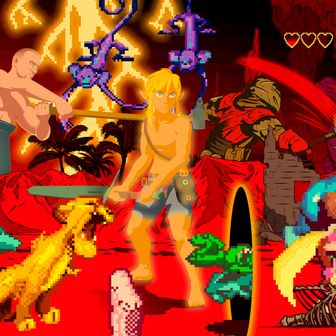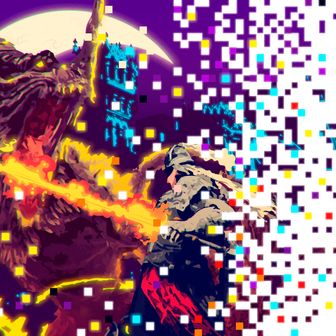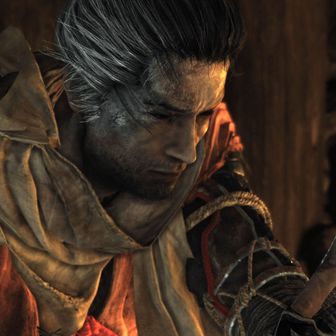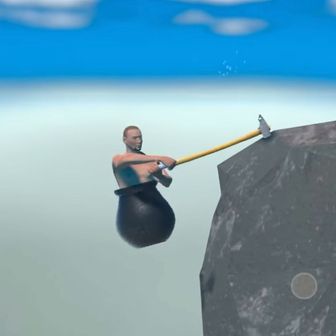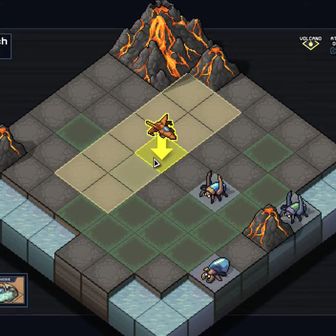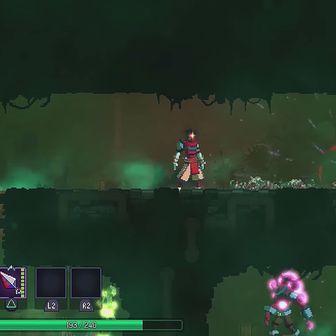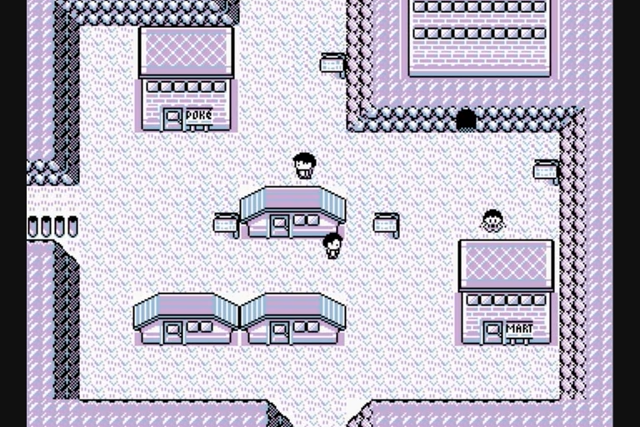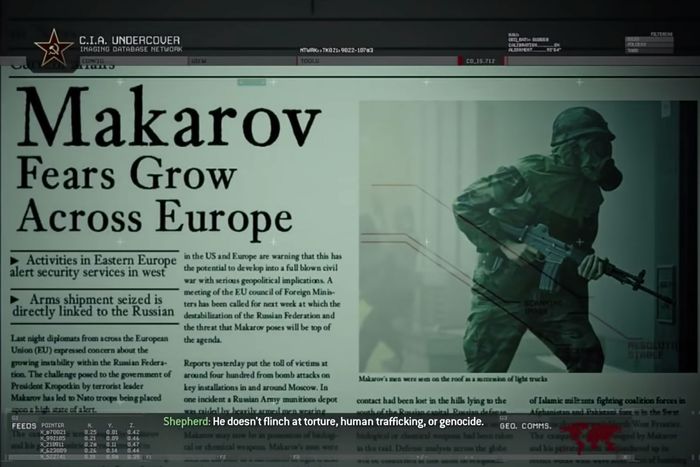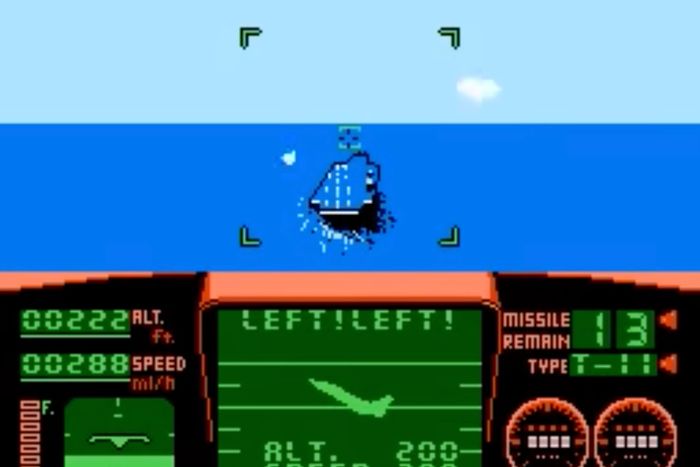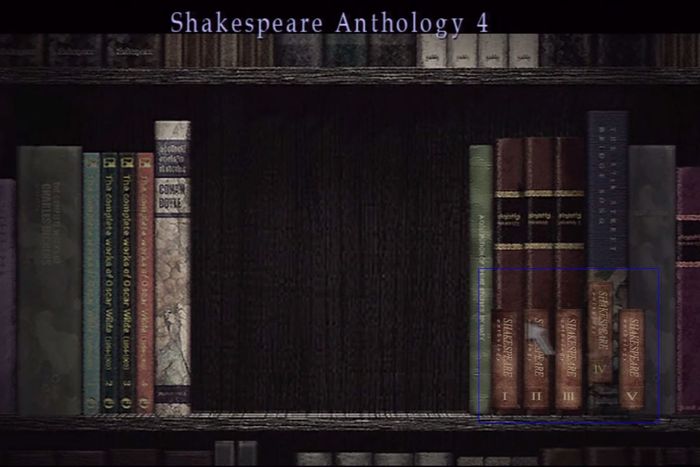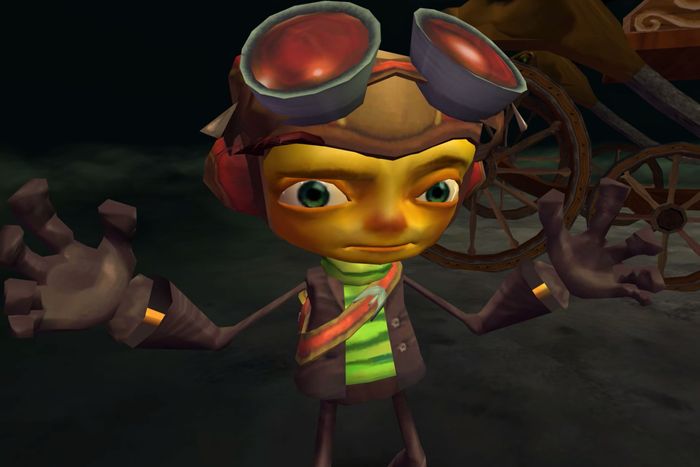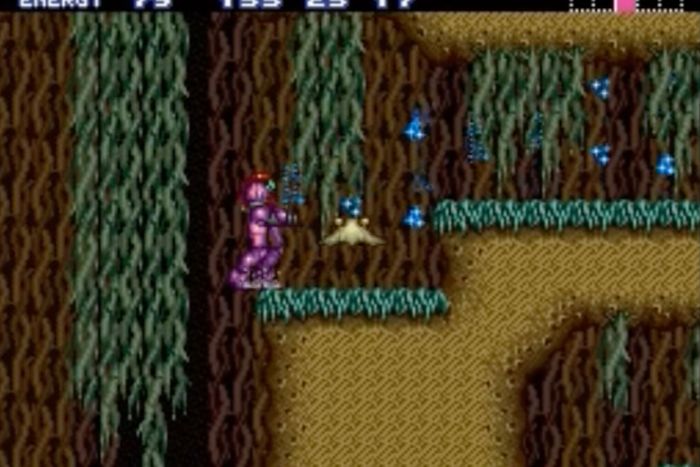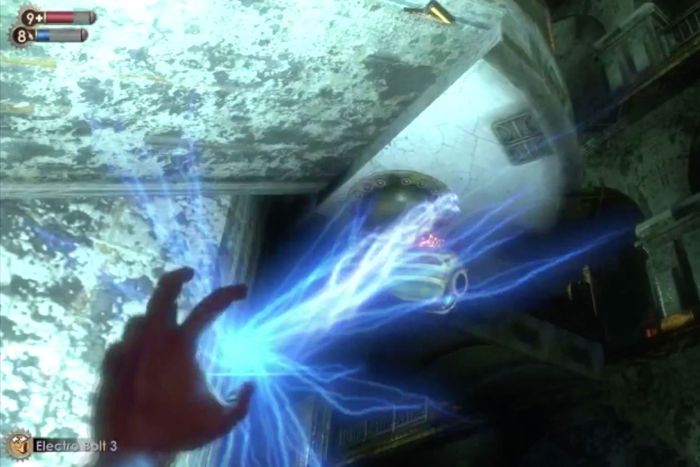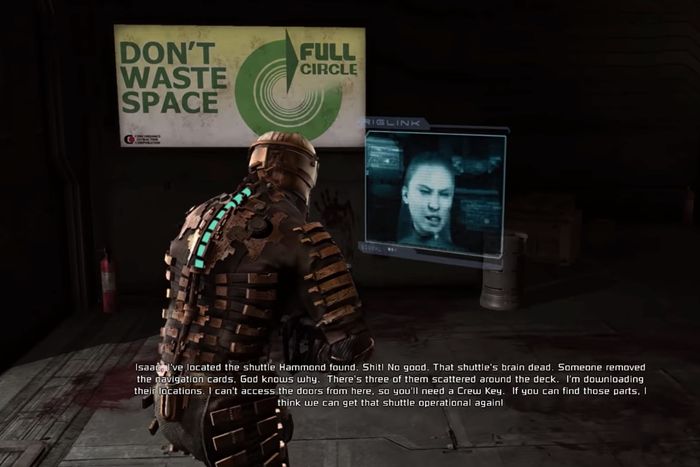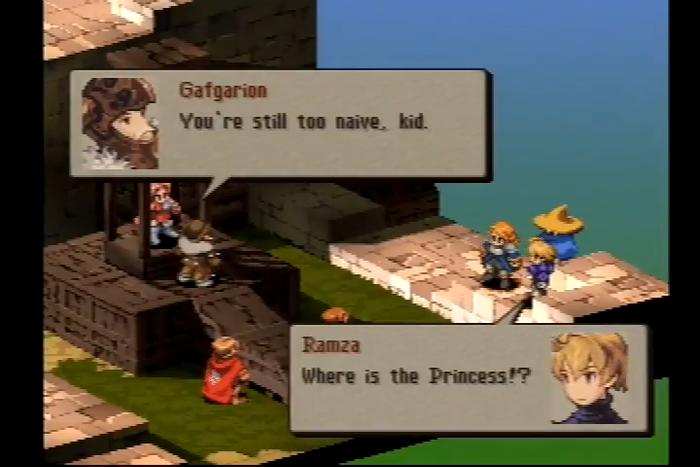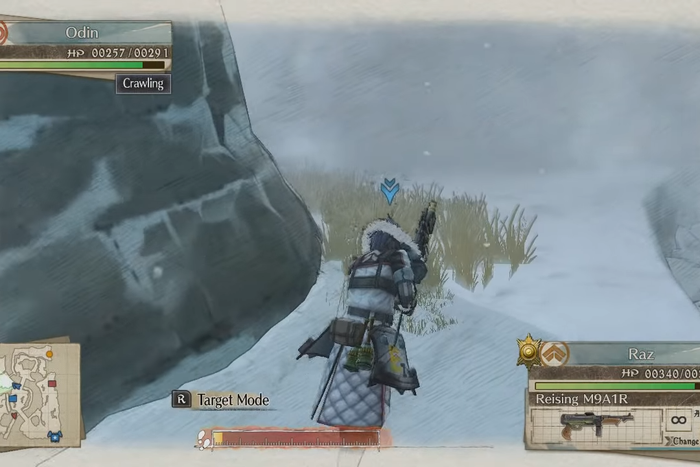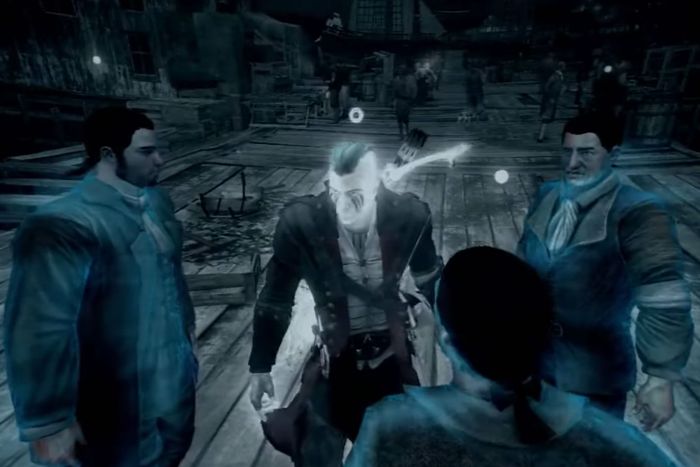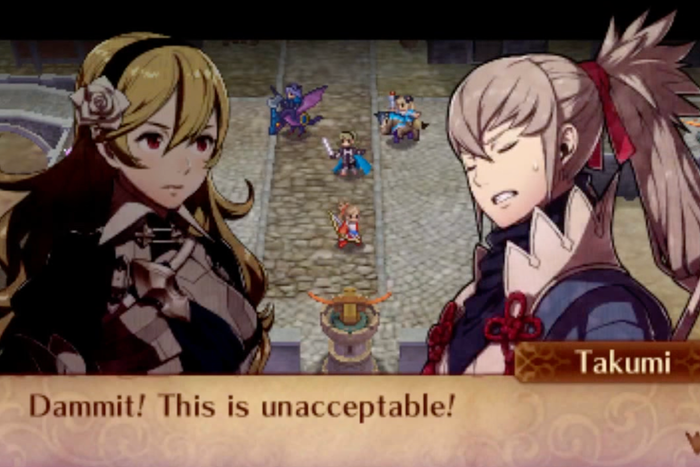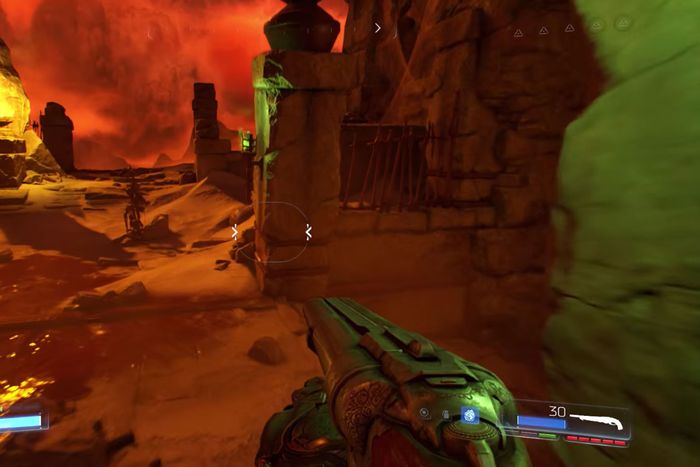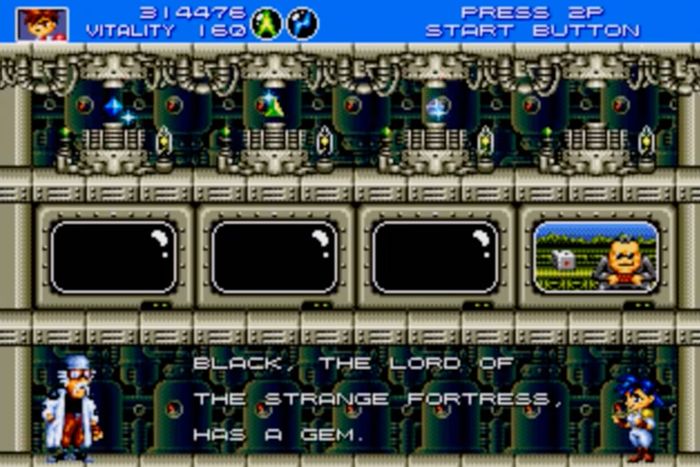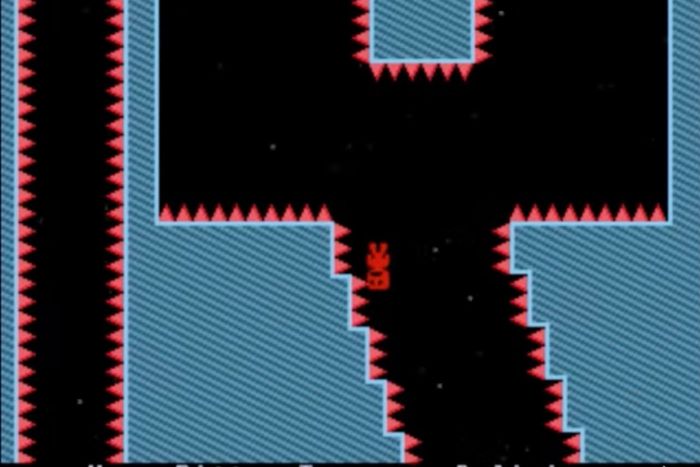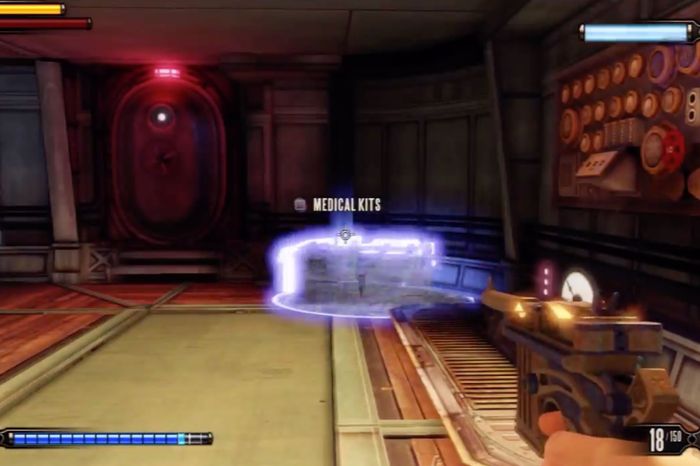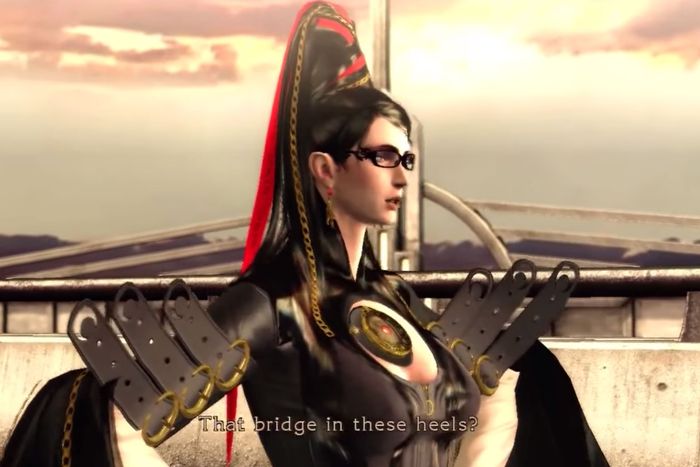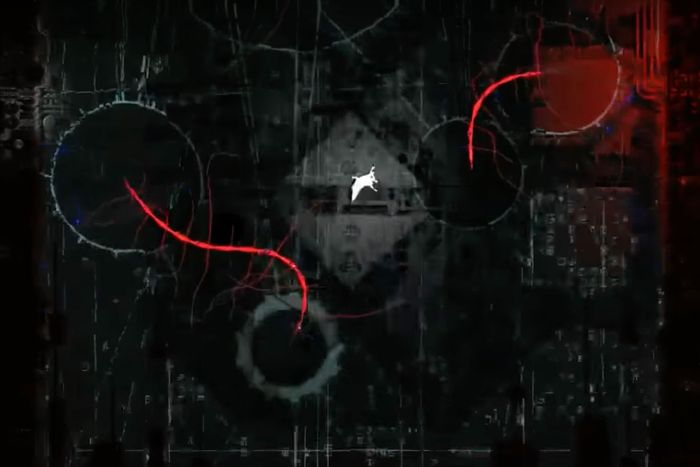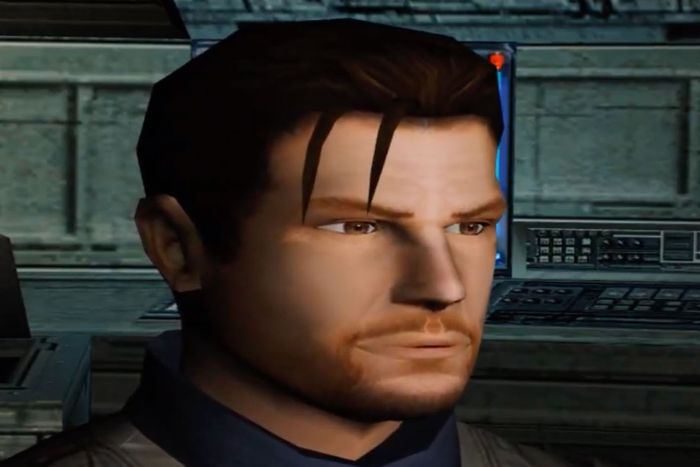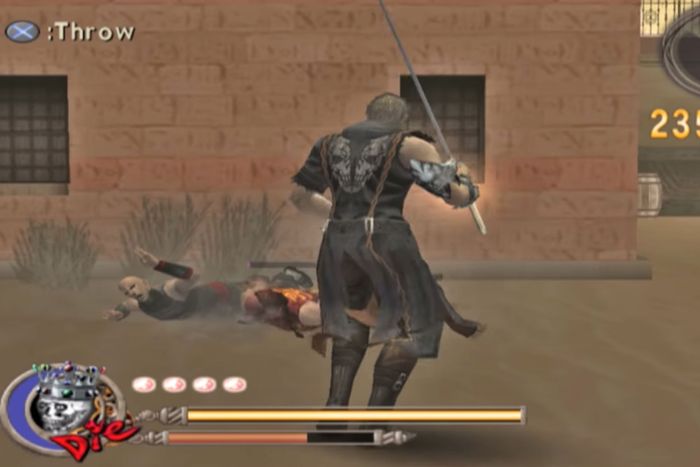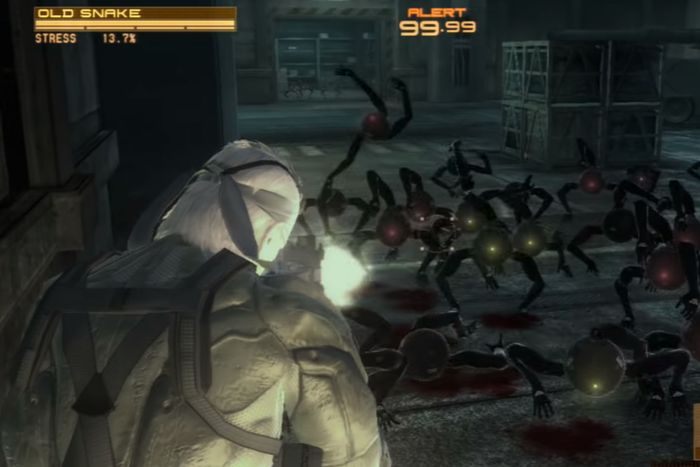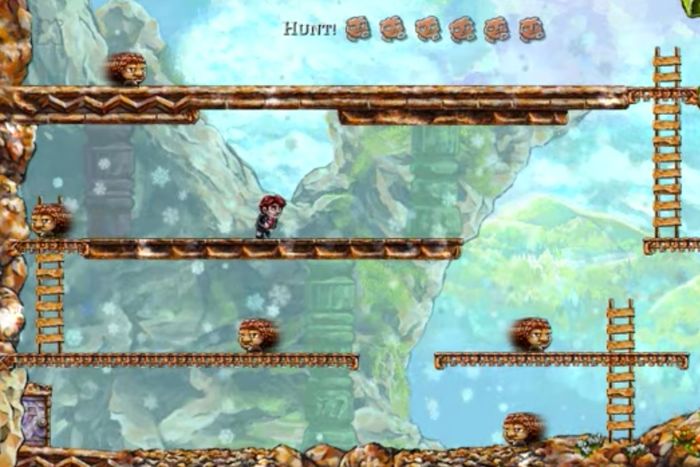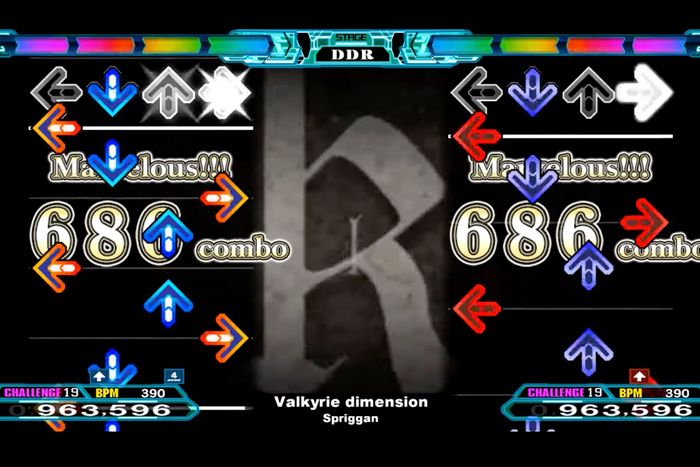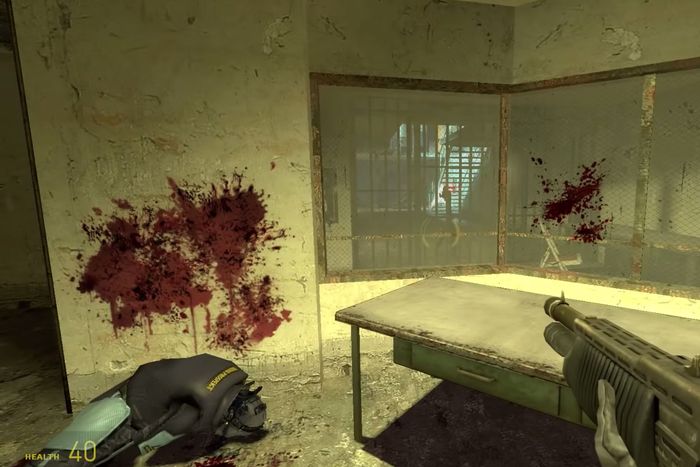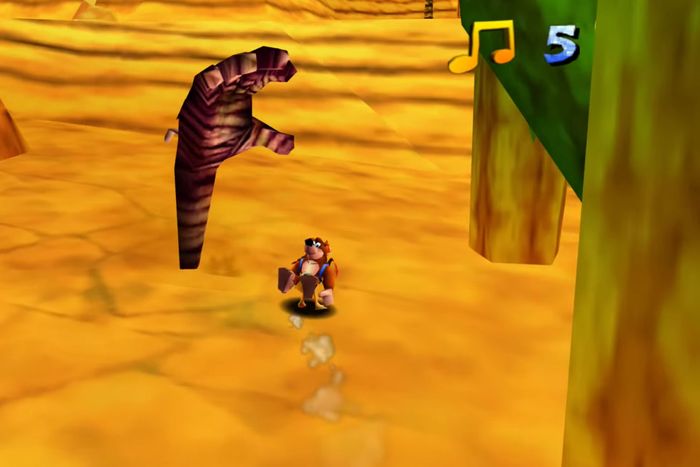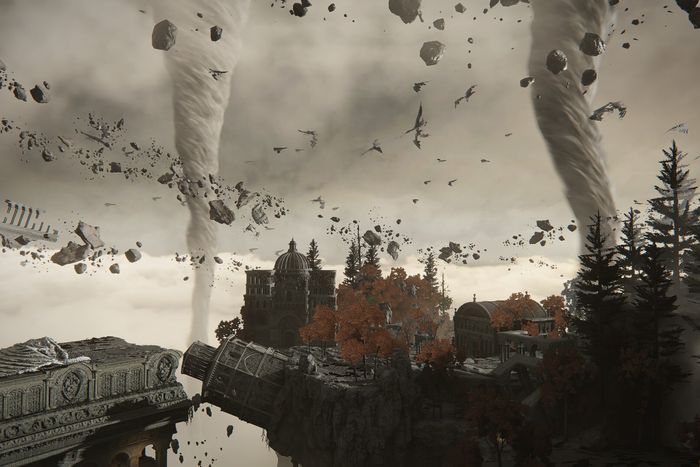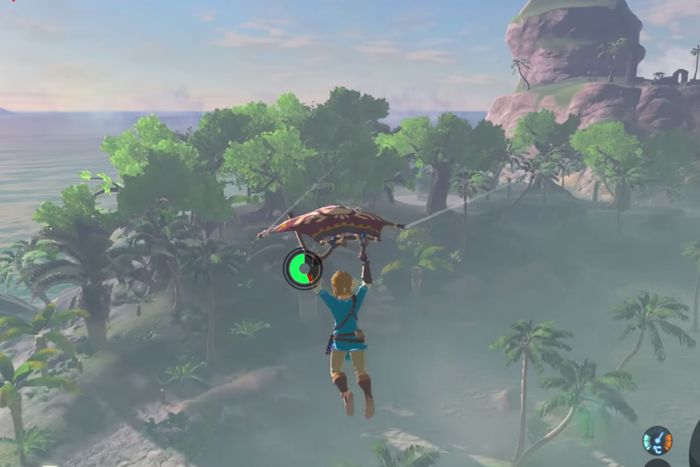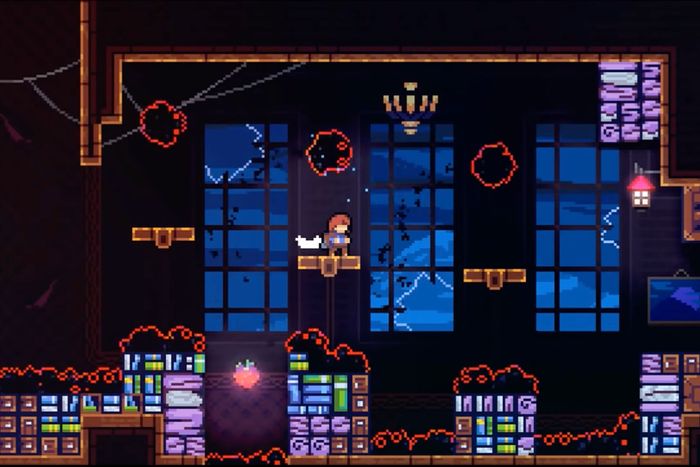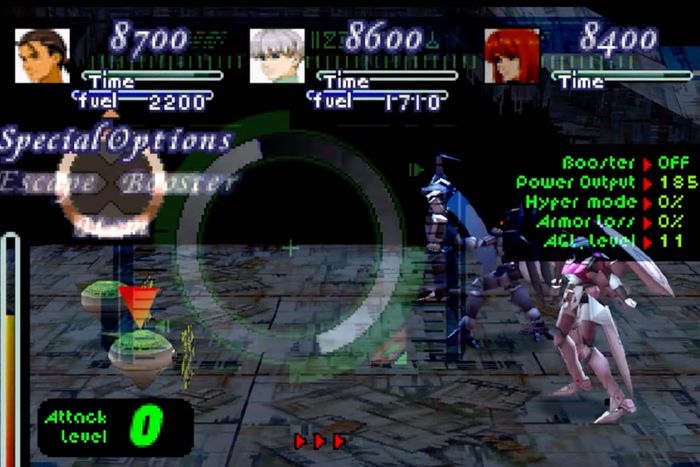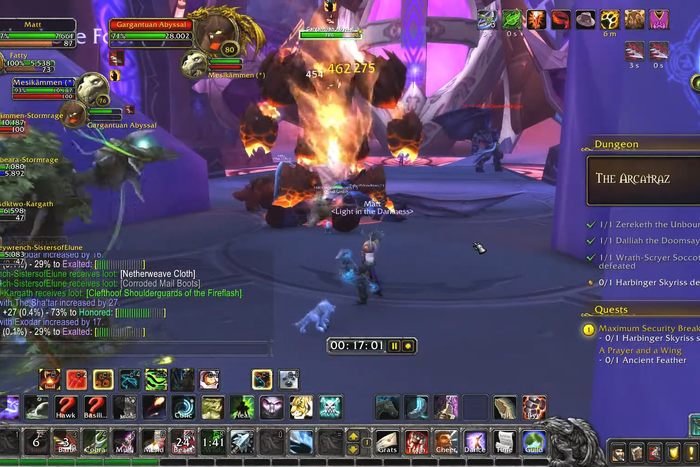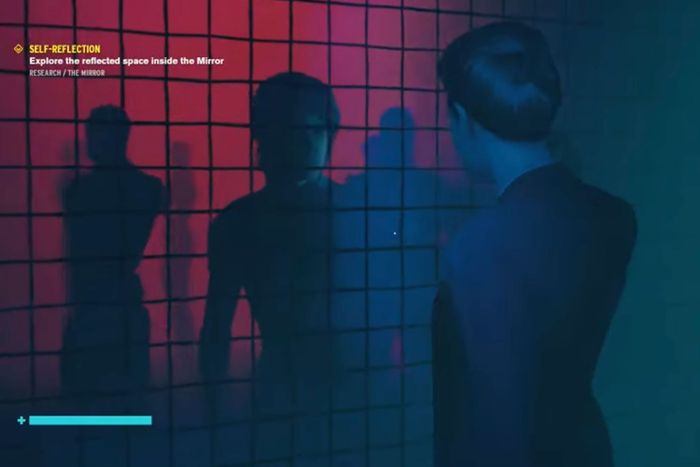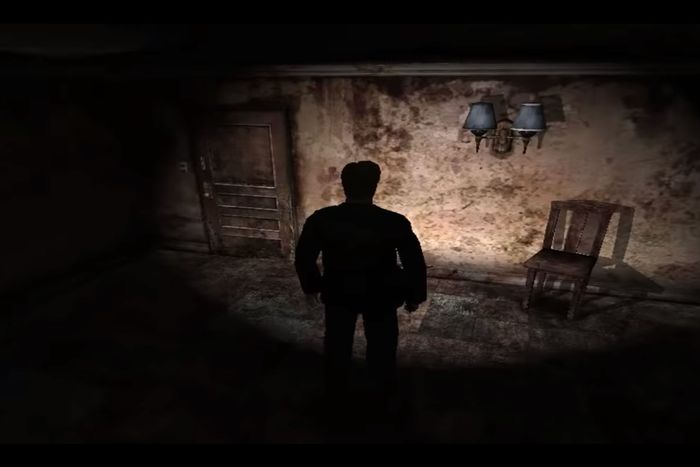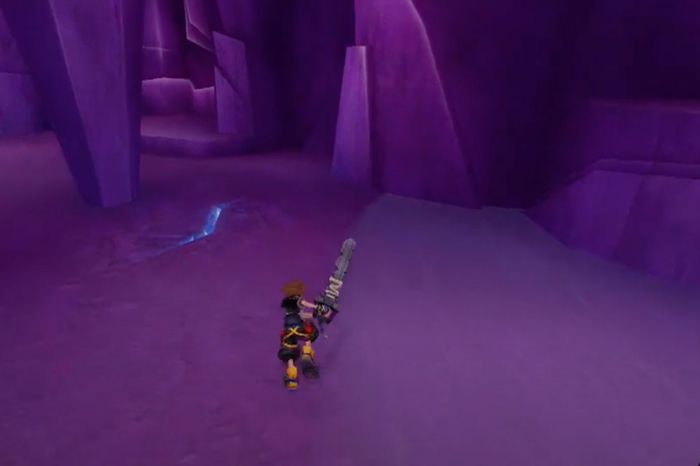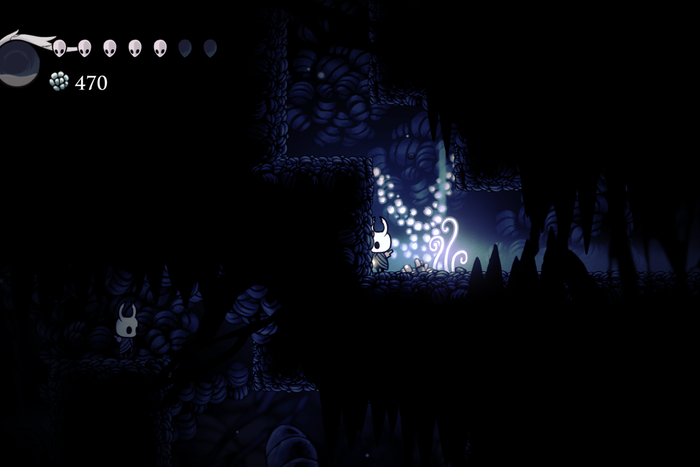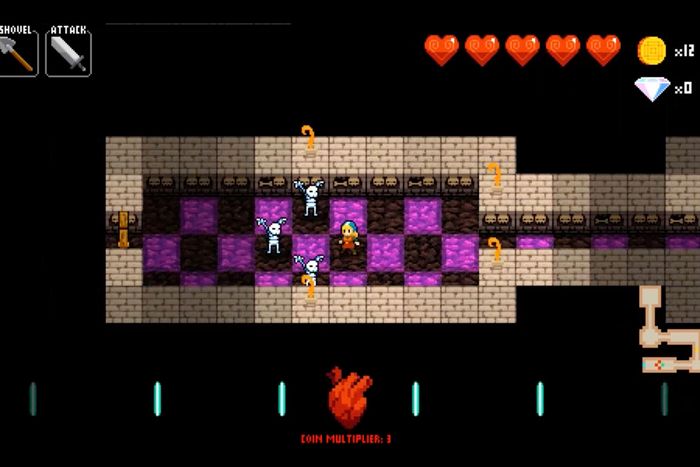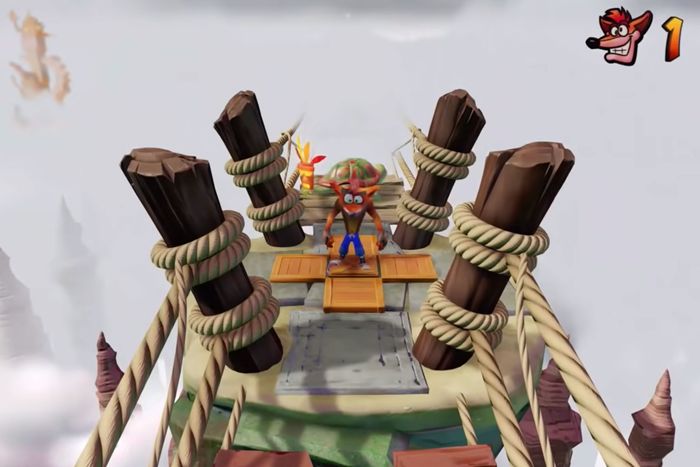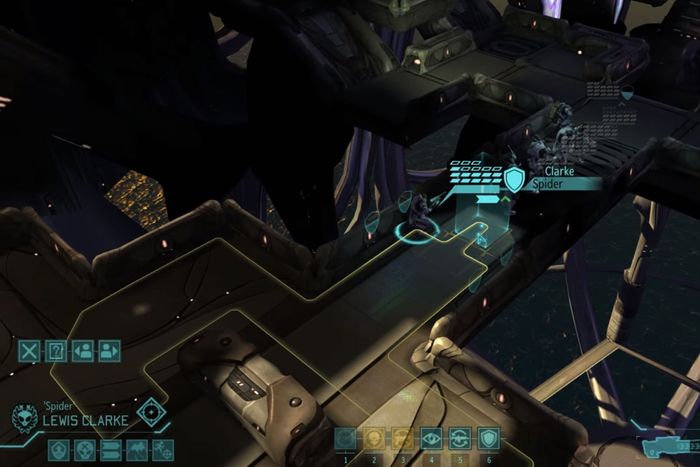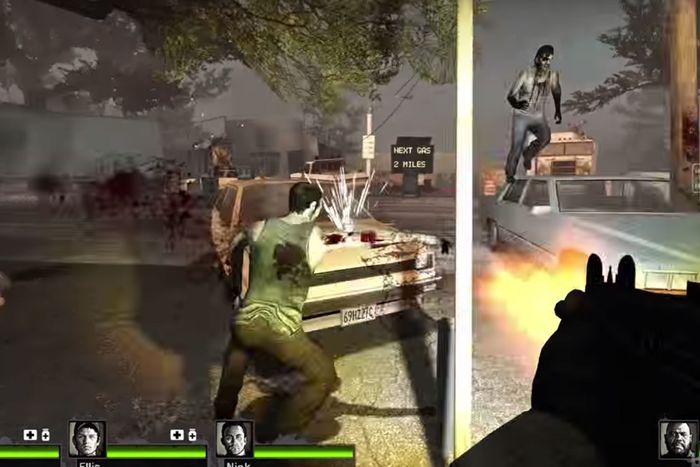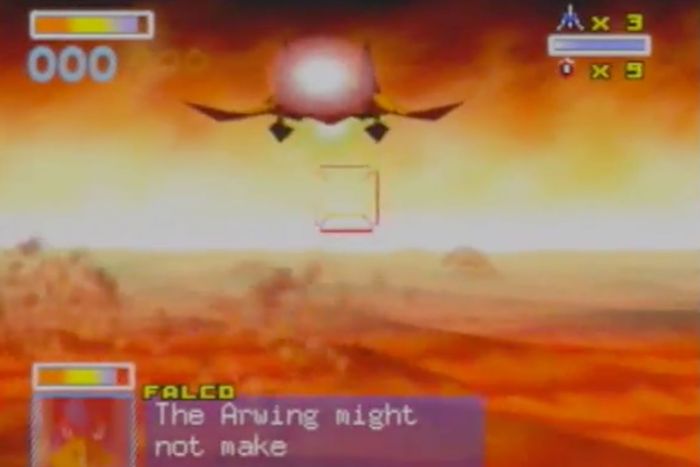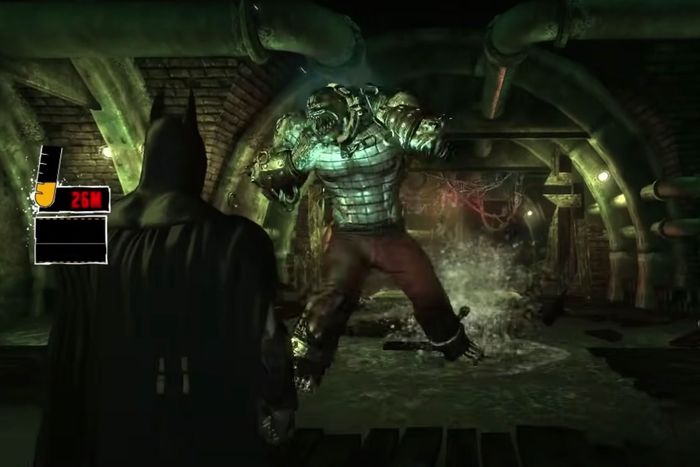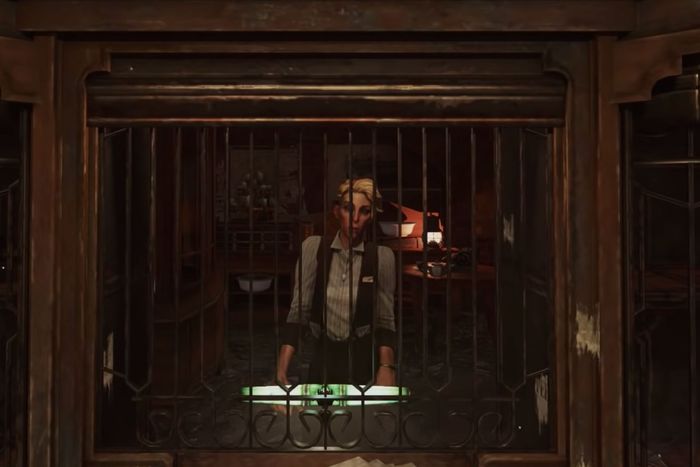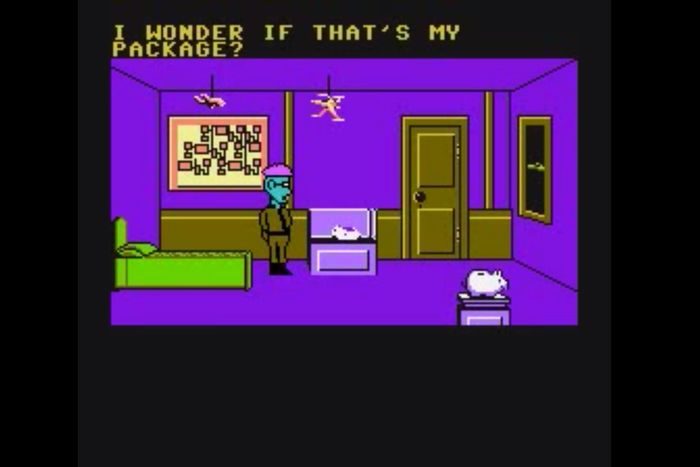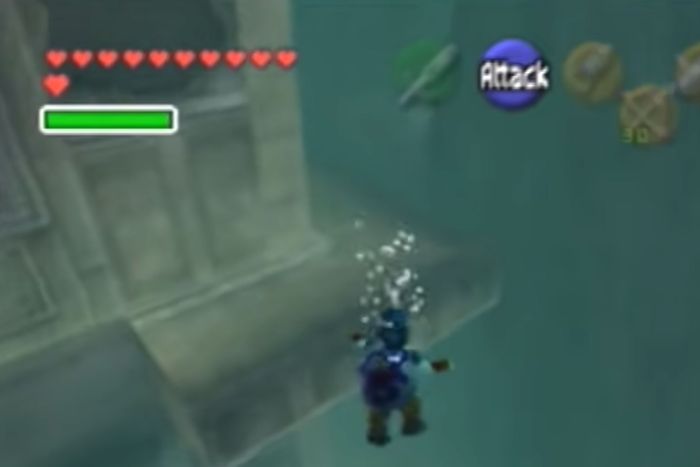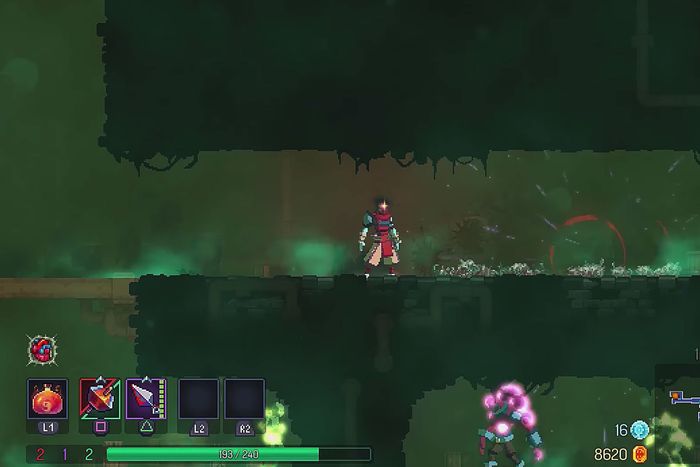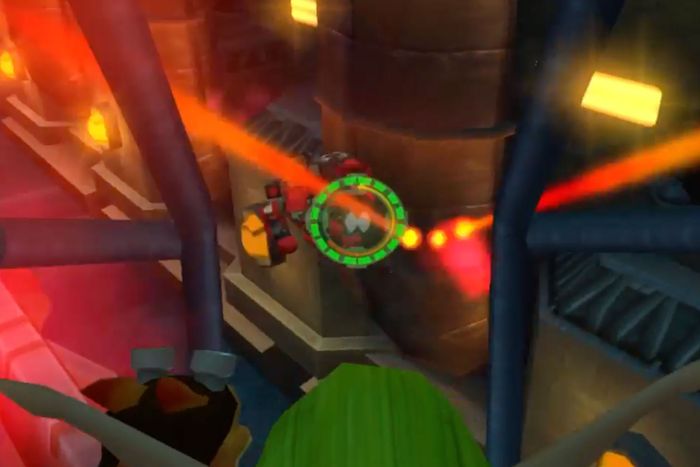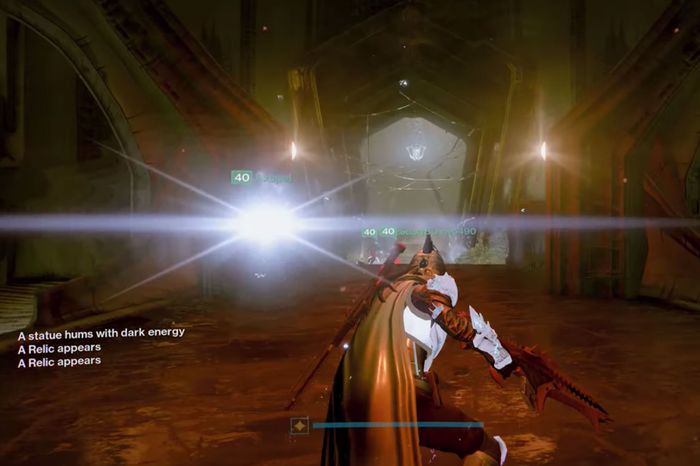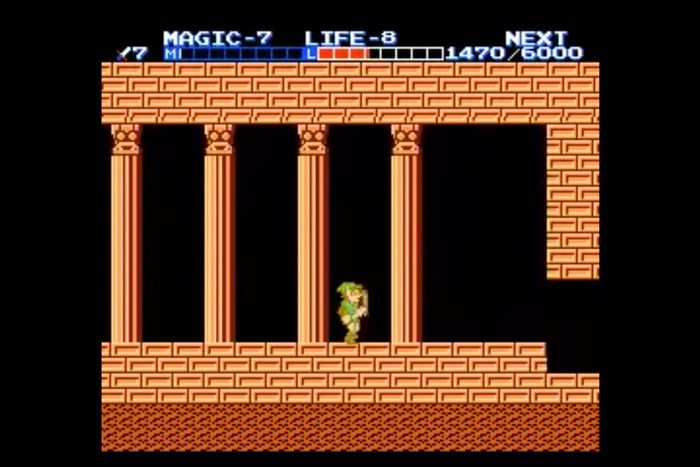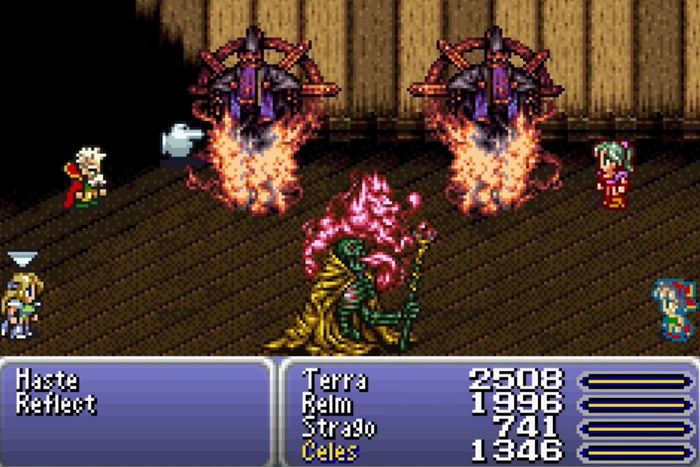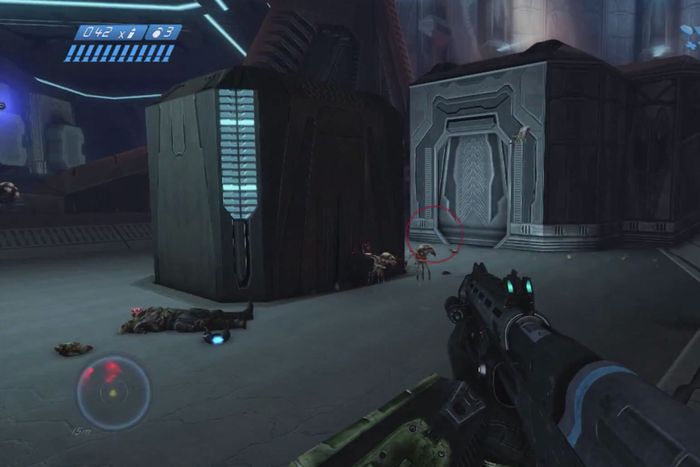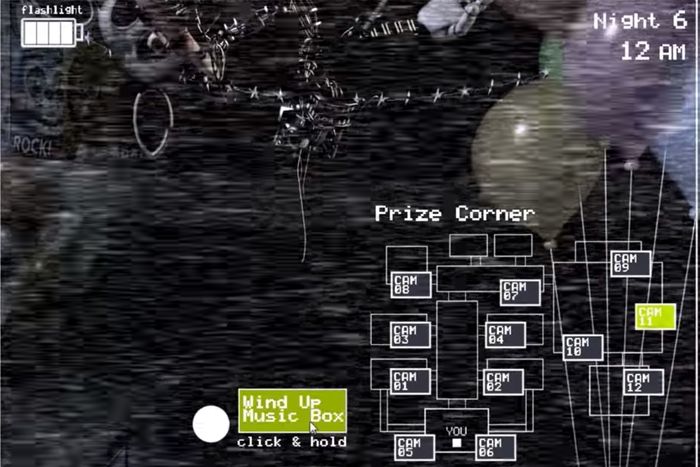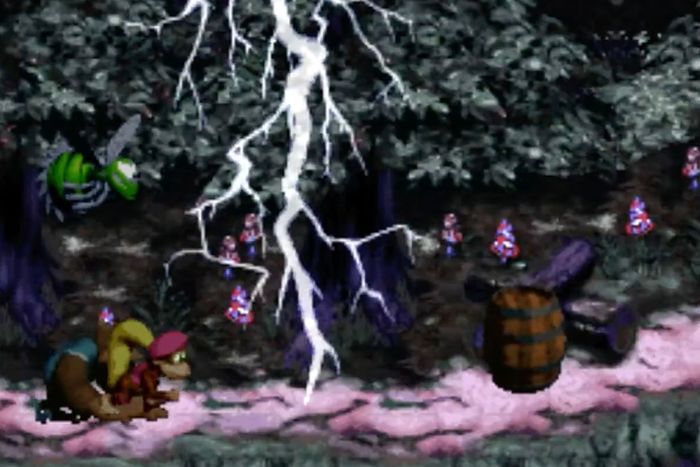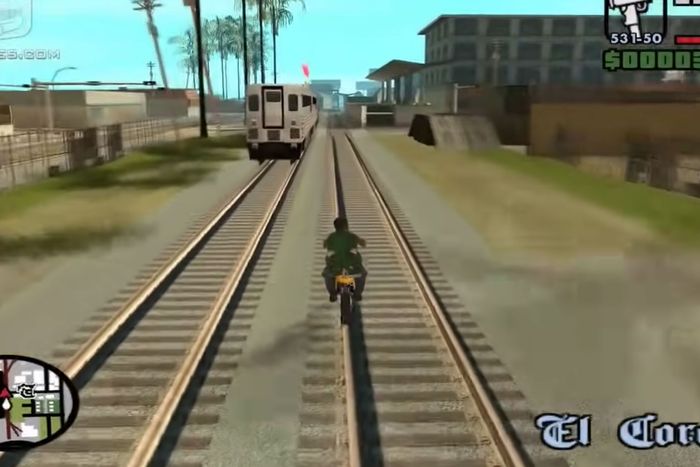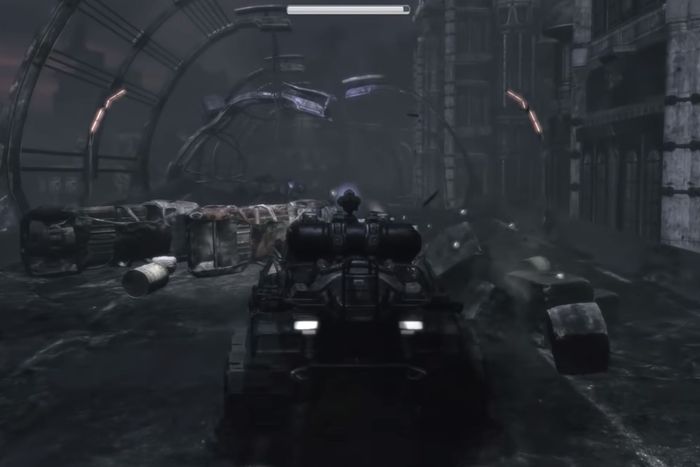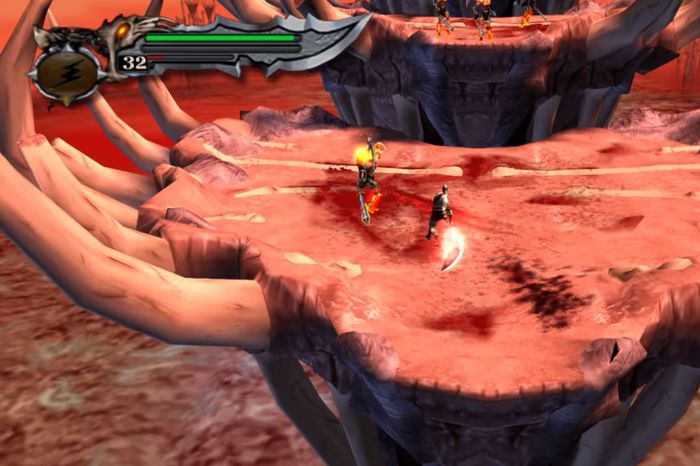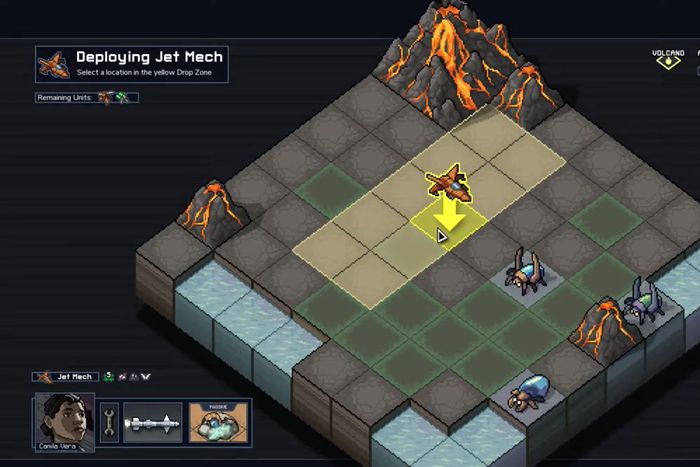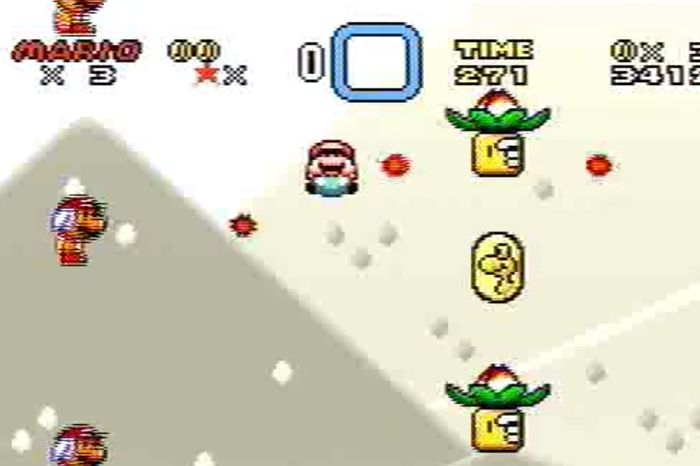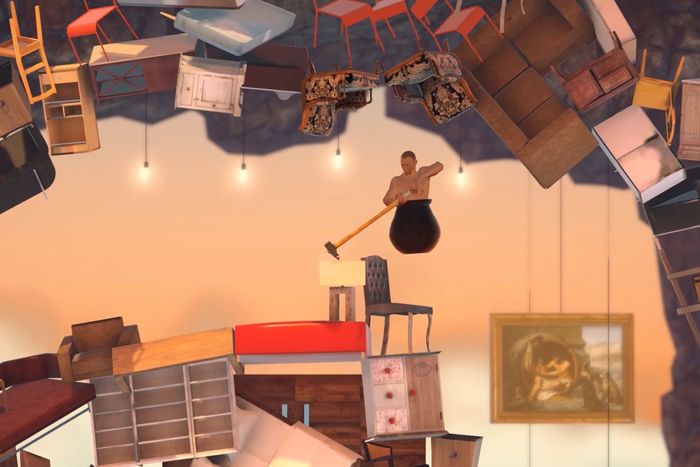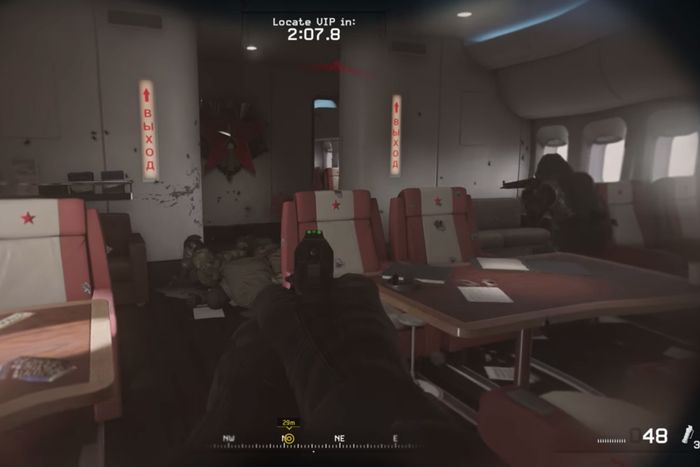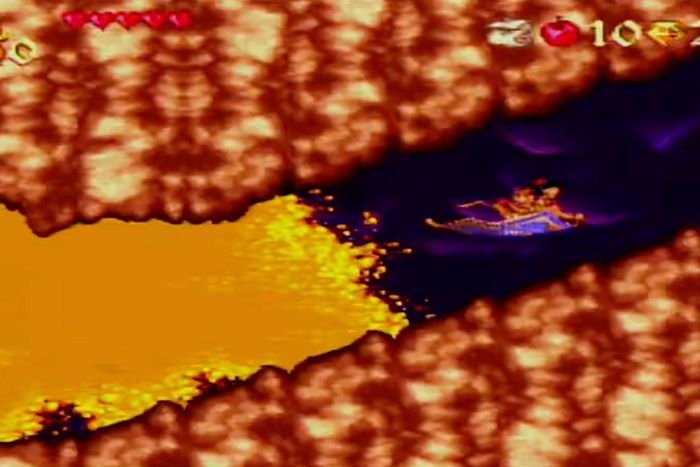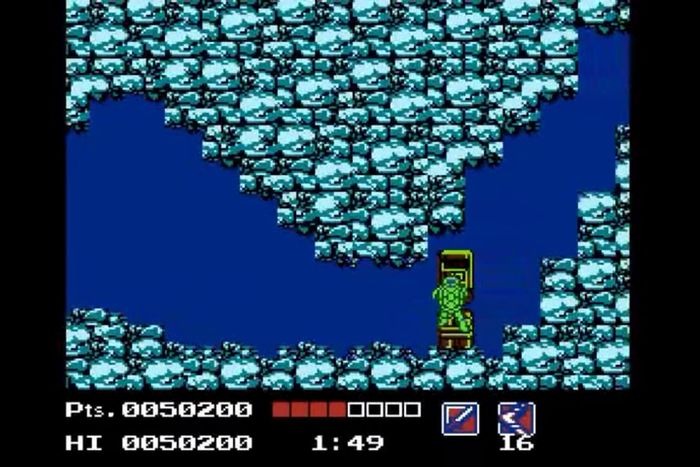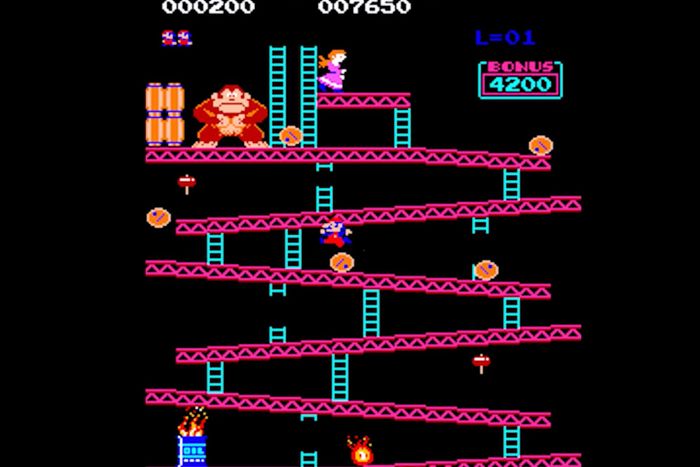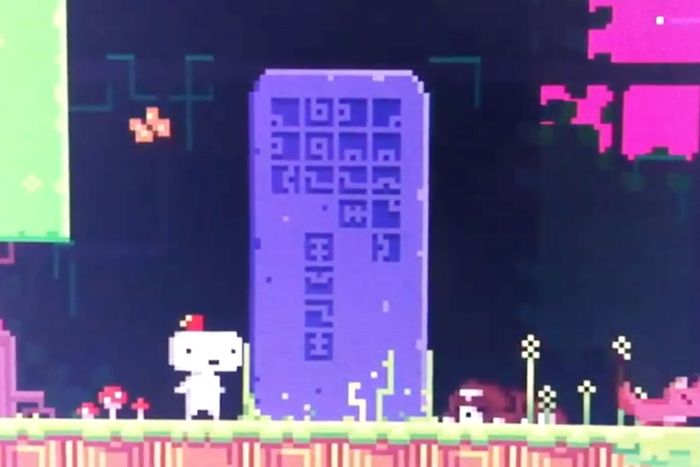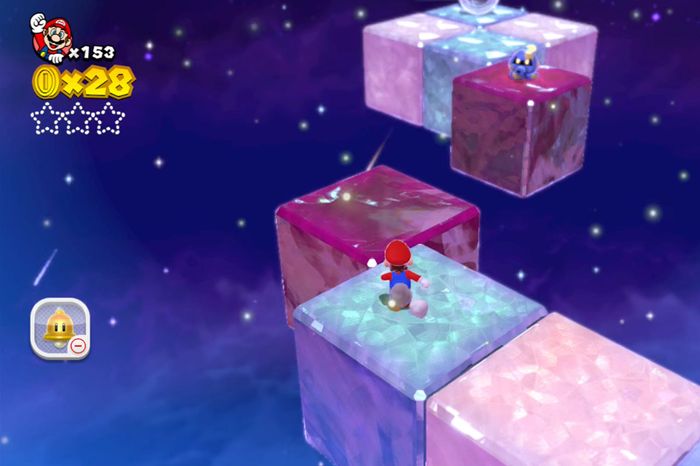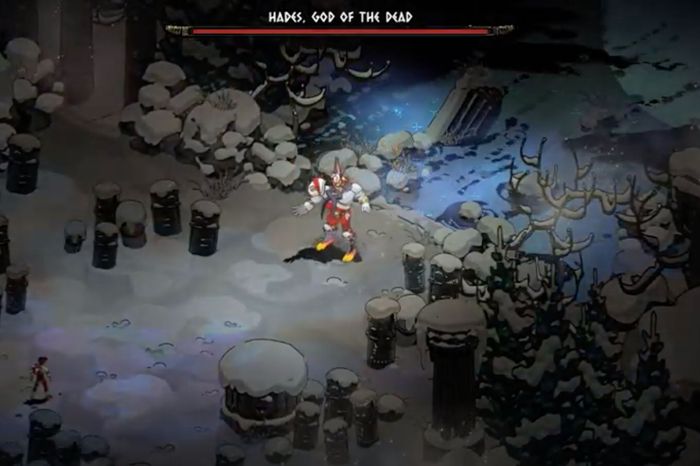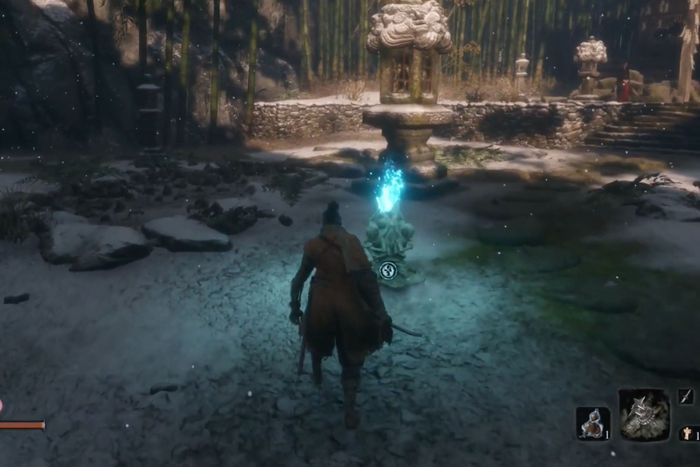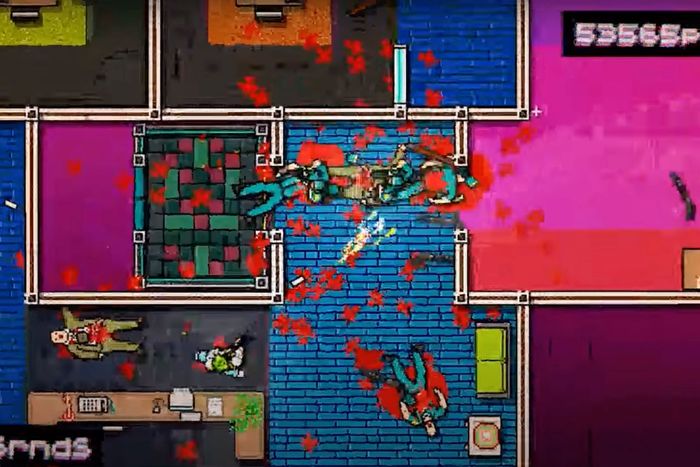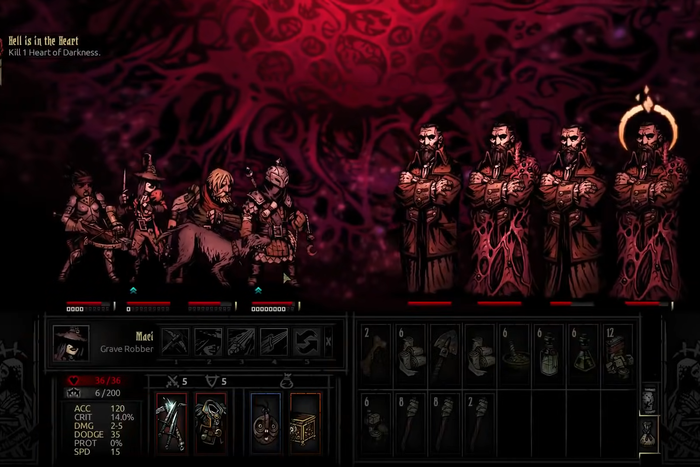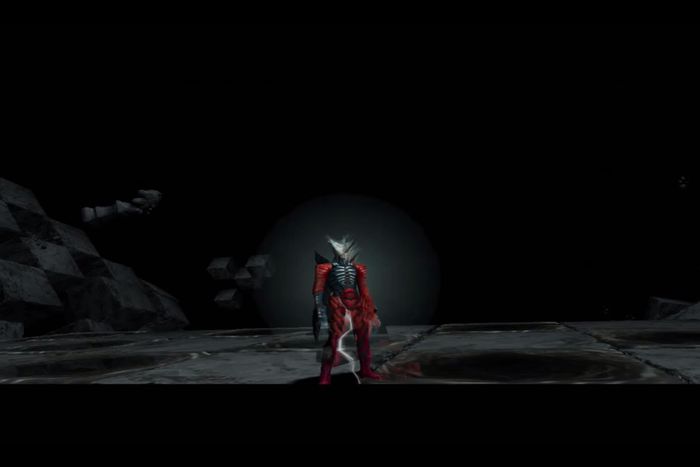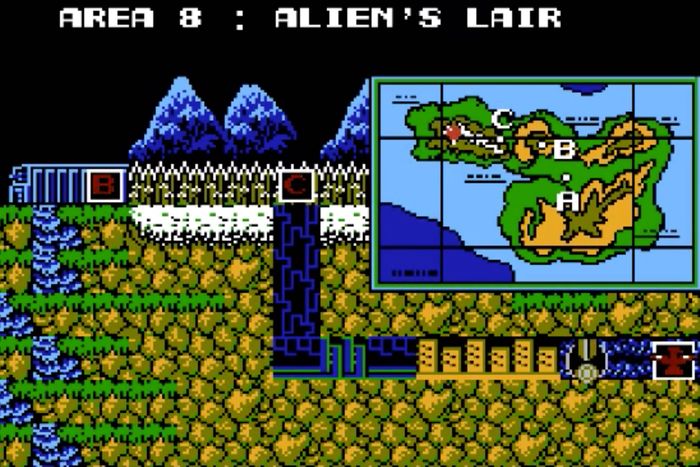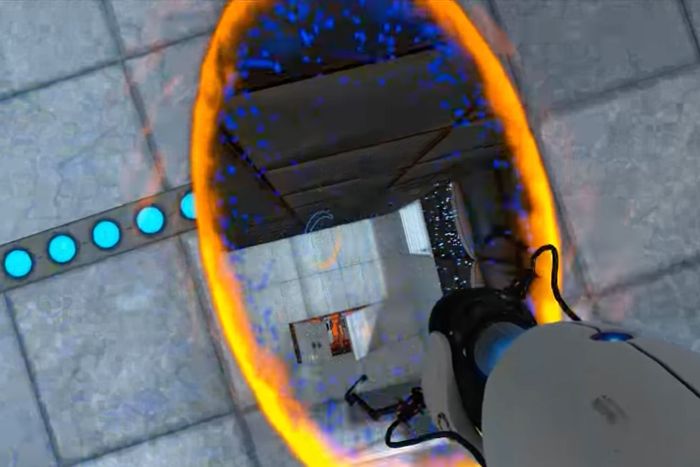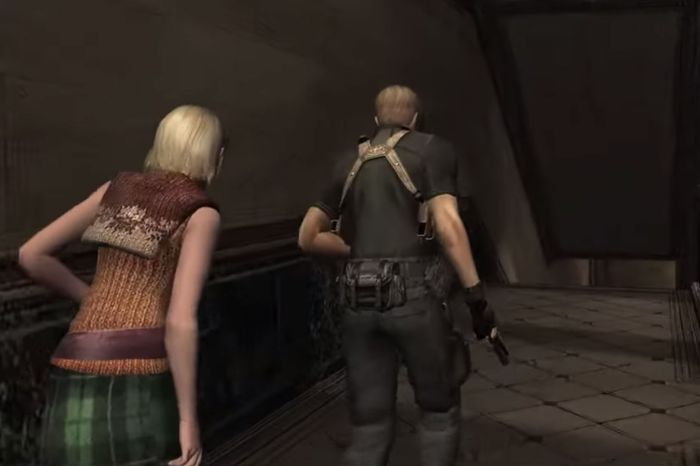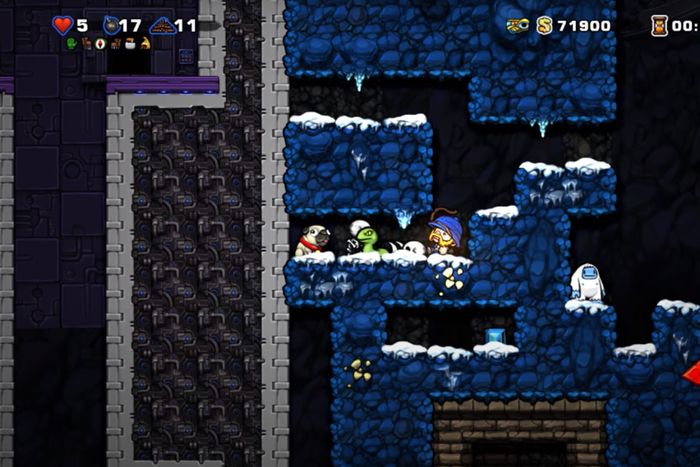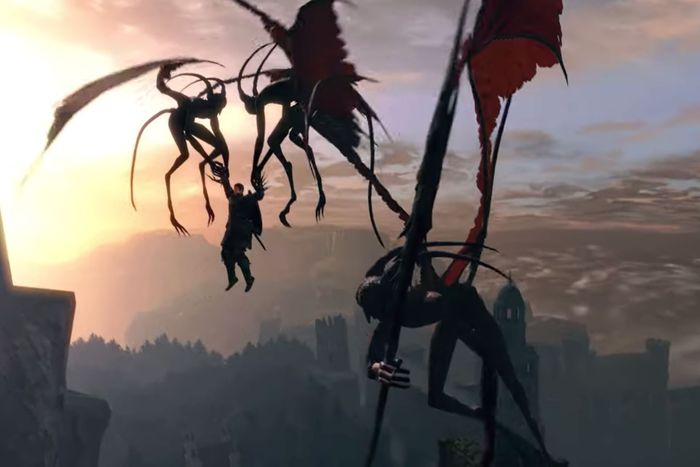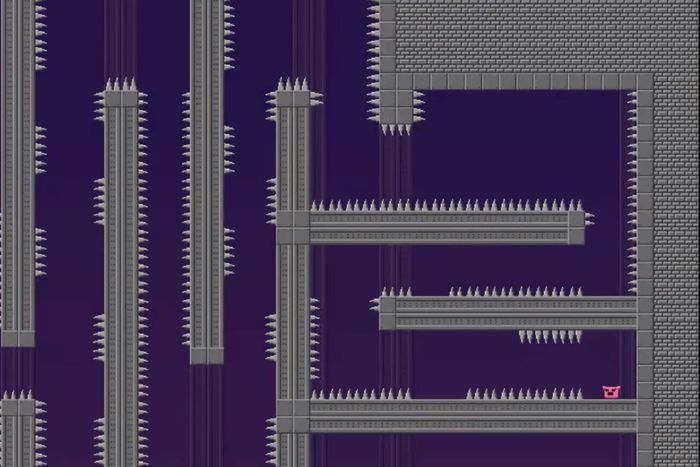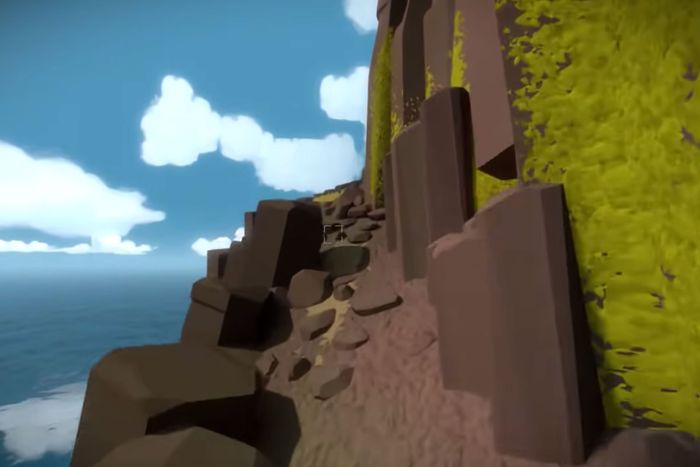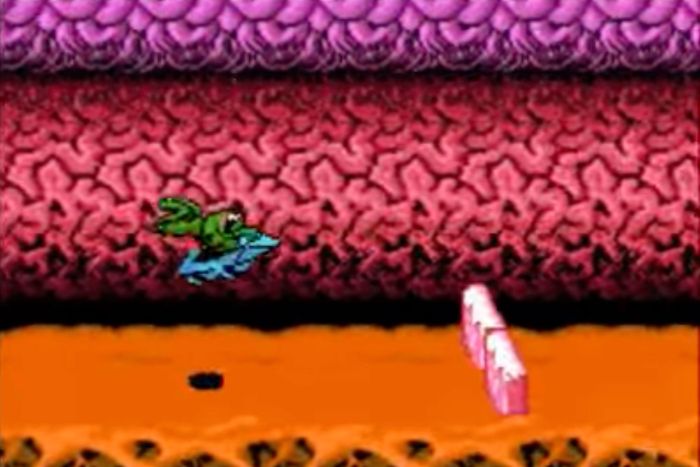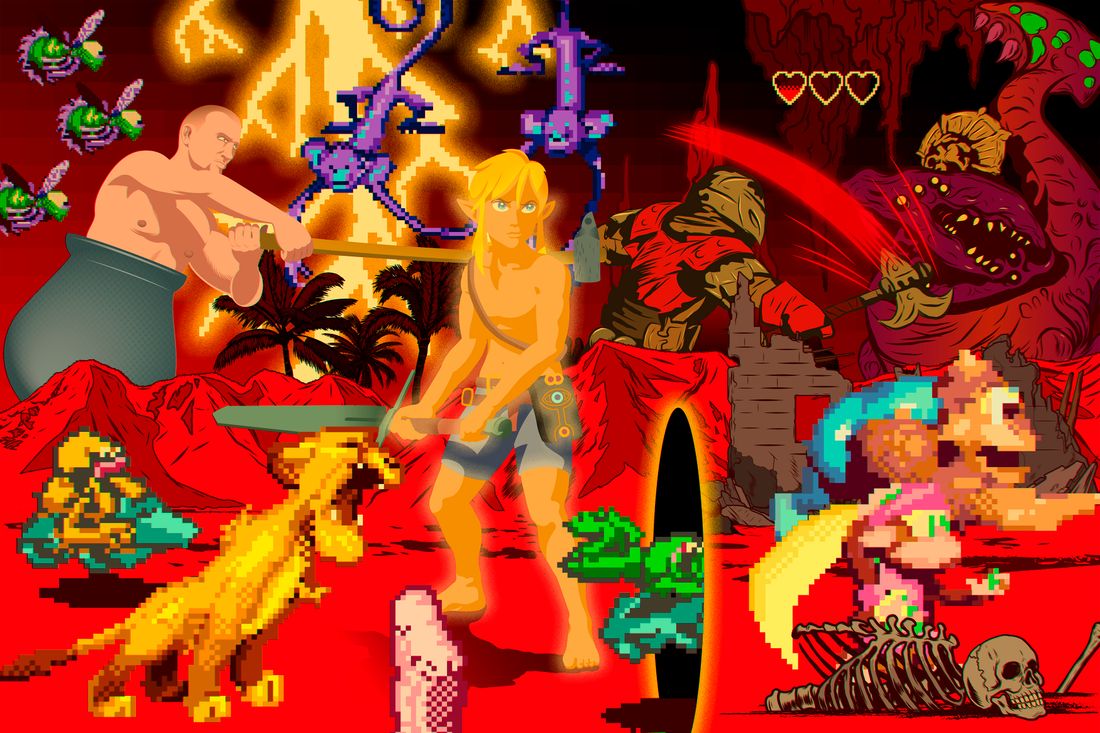
Video games are natural predators. In the earliest incarnation of the art — the arcade cabinets scattered across movie-theater lobbies and dentist waiting rooms in the ’70s and ’80s — you’d exchange a quarter for three lives and a dream. A few minutes later, once those ghosts claimed Pac-Man’s soul, or after Jumpman tripped over one too many of Donkey Kong’s barrels, you were sent back to your mother, tail between your legs, in hopes that she had a bit more spare change left in her purse. This was the business model; video games attempted to separate kids from their allowances as efficiently as possible, which was most easily accomplished through the blunt force of difficulty.
The modern home console-based games industry is almost unrecognizable compared to those early days. Extra lives are no longer stingily meted out between checkpoints, an easy mode is usually only a toggle away, and generally speaking publishers are more interested in immersing us in a story rather than humbling us with our inadequacies. And yet, even now, gamers have a grudging appreciation for a really tough level. They may not be as common as they were in the old days, when there was a direct financial incentive in thwarting players, but plenty of studios still crank up the meters to 11, eager to break our thumbs in two. In fact, with the mainstream success of games like Elden Ring and Returnal, difficulty seems to be coming back into fashion. We’re here to celebrate the tradition and hopefully get some closure on our collective anguish.
There are so many different ways to create a hard level. This list contains resource-draining RPG grinds, uncompromising tactical grids, mind-melting adventure-game puzzles, and the sort of quicksilver, arcade-y gauntlets that require a speedrunner’s acumen. (It does not contain, we want to note, The Legend of Zelda: Tears of the Kingdom, which came out too recently for us to confidently make a determination about whether any of its challenges warrant a spot. We reserve the right to add it at a later date.) We only looked at console and/or PC games released in the U.S. — meaning no arcade games (unless they were ported to a console) and no mobile-first games — and we created a few rules to guide our selections:
➼ The Flappy Bird Rule: Levels have a clear beginning and end.
➼ The Open-World Rule: As game styles evolve, so do level styles. Side quests can be levels; discrete sections of a map can be levels (as long as they follow the Flappy Bird Rule.)
➼ The ’90s Disney Games Rule: Intended audience matters. If a game was targeting young kids, how difficult was this level to that particular cohort?
In general, we attempted to weigh a given level’s difficulty relative to the rest of the game and relative to other games in its genre. Each level’s difficulty was considered in the context of when the game was released — How hard was this when it came out? — since subsequent accumulation of knowledge, online resources, simplified rereleases, and better technology have made some of these stages more manageable over time. The impact of technology was taken into account, too: The difficulty of some games on the list was compounded by the inadequate controllers of their era.
Preference was given to levels that are honorable with their difficulty; a good, satisfying hard, rather than “Are we sure this isn’t a bug?” hard. This was tougher to suss out when reflecting on gaming’s Cretaceous period, specifically the death traps that tormented us on the NES. Is Battletoads a well-designed game? That’s a question we could spend another 20,000 words trying to answer. Enjoy the list, and please tread carefully and stay hydrated if you tackle any of these levels yourself.
100.
Lavender Town
Pokémon Red, Blue, and Yellow (1996; Game Boy)
When Pokémon Red and Pokémon Blue — the first entries in the creature-catching franchise — came to the U.S. from Japan in 1998, gamers couldn’t just Google the best strategies, especially when it came to how best to use different types of Pokémon against each other. Instead, as players traveled around trying to “catch ’em all,” they had to learn which Pokémon were most effective in battle against other types. Some matchups are fairly intuitive: Water, as you might expect, beats Fire. Others, such as Bug beating Psychic, relied entirely on trial and error.
It was in this information vacuum that Lavender Town proved to be such a huge challenge. The spectral Pokémon Gastly and Haunter, which populate the spooky tower, are impossible to even fight without first completing a side quest in a different town. Then, once you are able to battle them, it’s still notably difficult. These part-Ghost, part-Poison types have unintuitive weaknesses (especially since one of them, Ghost type itself, is extremely rare and there are no good damaging-Ghost moves in the game). Would-be Pokémon masters used up all their potions while battling their way up a maze-like tower. And then you had to fight your hated rival, again, at the top. Lavender Town might not hold up as an especially difficult level a couple decades later, when resources such as Bulbapedia contain all the type matchups a player needs. But our desperate memories will haunt us forever.
99.
No Russian
Call of Duty: Modern Warfare 2 (2009; PlayStation 3, Windows, Xbox 360)
No Russian became controversial the moment footage of the level leaked a month ahead of Call of Duty: Modern Warfare 2’s November 2009 release. Taken out of context, it appeared that players would be joining up with terrorists to gun down innocent civilians in a Moscow airport. In context, as everyone discovered when they got their hands on the game … that’s more or less exactly what happens.
When the level arrives early in MW2, you’re in the perspective of one of the game’s five player characters, the CIA agent Joseph Allen. He’s assigned to go undercover and infiltrate a terrorist group in order to gain the trust of Vladimir Makarov, the group’s leader and the game’s main antagonist. You can’t reveal your true identity, even as you watch Makarov’s men massacre scores of helpless people at the airport.
It’s hard to play, for reasons that have nothing to do with mechanics; tellingly, the game offers the option to skip the mission entirely. Plenty of mainstream games ask you to make difficult, emotionally devastating choices. The Mass Effect series is full of them, often leading to no-win scenarios. Life Is Strange ends with a decision to either sacrifice the girl you love or let your entire town be destroyed. (See also Valkyria Chronicles 4’s Mission 16 below.) But in No Russian, you have no agency. No matter what you do, you can’t stop the devastation. If you try to take out the terrorists, you fail the mission and have to start all over again. In the end, you’re left feeling emotionally spent, and the sacrifice doesn’t even matter: You’re found out, Allen is killed, and you simply continue the story as one of the other four characters. All of that death and sacrifice was for nothing. It might be the most apt statement Call of Duty has ever made about war.
98.
The Club
Sifu (2022; PlayStation 4, PlayStation 5, Windows)
The cinematic beat-em-up Sifu, which was inspired by martial-arts movies, has an intriguing premise: Each time you die while battling through the game’s five levels, you’re revived — but your character has aged a few years. Eventually you reach old age, and your next death will be your last, sending you back to the beginning of the game to start all over again. It’s a neat mechanic, if an occasionally frustrating one — especially since Sifu’s second level, The Club, unleashes such a dramatic difficulty spike that you’ll be lucky to finish it with only a smattering of gray hairs and wrinkles.
The Club opens in furious style, a brawl on the dance floor accompanied by composer Howie Lee’s pummeling soundtrack. From there, the game throws an ever-escalating series of opponents at you: Two gigantic henchmen guarding the backstage entrance; a pack of bruising cage fighters; a pair of staff-wielding martial artists; to cap it off, a showdown with the dojo master himself. The Club is so difficult compared to Sifu’s first level that, in the week after the game’s release, it was reported that only a third of players made it through. How many other second levels can lay claim to having driven away the majority of its player base?
97.
Landing on the Aircraft Carrier
Top Gun (1987; NES)
Dogfighting in Konami’s adaptation of Top Gun wasn’t very difficult: Bogeys moved slowly in the combat flight simulator, enemy missile lock-ons were easy to dodge, and your F-14 Tomcat plane came loaded with 40 (40!) missiles. Even so, most players never reached the later levels because most players ended up slamming their jet into the ocean while attempting to land.
The primary objective in each of the game’s four missions is to fight off enemy planes before destroying a variety of large targets. Along the way, however, players were required to perform a pair of similar maneuvers: refueling your F-14 in mid-air, then landing on an aircraft carrier following the completion of a mission. Both tasks require you to keep your plane relatively flat while following onscreen guidance about how to adjust your speed and flight path. Problem is the directions are frenetic and require precision that is at odds with the NES controller’s capabilities. Landing on the carrier is especially difficult because the pixelated screen gives no real indication that you’re actually on a good flight path: You could be making an approach with no warnings and still hit the ocean. It turns out that the secret is ignoring the game’s urgent directives and making only small course corrections. But it’s still tricky to pull off even once, much less the three times necessary to beat the game.
96.
Central Square Shopping Center: Shakespeare Puzzle on Hard
Silent Hill 3 (2003; PlayStation 2)
Each game in the third-person survival horror series Silent Hill takes place in the titular small town, home to a mysterious cult that seeks to revive a malevolent deity. Gameplay involves elements of combat, exploration, and puzzles, the last of which are some of the best designed — and toughest — in gaming thanks to a randomness that involves, say, tugging on a hanging corpse to find a key to unlock a set of handcuffs. Silent Hill 2 and Silent Hill 3 mercifully enable players to toggle the difficulty settings on the puzzles, and no brainteaser embodies the jump in complexity when going from easy to hard quite like Silent Hill 3’s Shakespeare Anthology Puzzle.
The set-up is that the game’s protagonist, Heather, comes across a pile of books at the mall bookstore, and has to put them in the correct order in order to continue. On easier difficulties, it’s a straightforward mission — you don’t even get a riddle to decipher. But on Hard, you need both an ear for wordplay and working knowledge of Shakespeare. One line reads, “The first words at thy left hand: a false lunacy, a madly dancing man. Hearing unhearable words, drawn to a beloved’s grave and there, mayhap, true madness at last.” (If you’re stumped, it’s telling you to line up the assembled Shakespeare anthologies with Hamlet to the far left.) It’s a puzzle so difficult, there’s room for error built into the solution: you can still get the answer right even if you mix up the books in the middle.
95.
Meat Circus
Psychonauts (2005; PlayStation 2, Windows, Xbox)
The final level of Psychonauts, a 3-D platformer in which a psychic boy named Raz helps people overcome various mental obstacles by jumping inside their heads, had such a reputation for being punishing that the developers made it substantially easier in later rereleases. The game’s stages are based around Raz entering the minds of people or things to resolve their fantastically analogized trauma — for instance, in the Lungfishopolis level, the game takes you inside the head of a fish boss that you’ve just defeated, leading you to better understand her motivations as you help fix her problems.
That approach builds to the final act, Meat Circus, which combines Raz’s recollections of his childhood as a traveling circus performer with the upsetting memories that antagonist Coach Oleander harbors of his father’s butcher shop. The result is a horrifying mash-up of flesh and clowns for you to navigate. A lot of the challenge comes from things outside your control: an escort mission with a dumb child named Oly who has finite health and knife-throwers you need to manipulate into attacking certain spots. Then there’s a stretch of precision platforming with little room for error, lives that slip away as you miss jumps, and few checkpoints. Later versions admitted it was too tough by changing all of that: increasing Oly’s health substantially, slowing down the knife-throwers, adding checkpoints, and no longer taking lives from deaths by falling. Even with all those changes, Psychonauts was always more beloved for its writing, characters, and imaginative design than its somewhat floaty gameplay, and Meat Circus is where that was felt most acutely.
94.
Warehouse Infiltration
Crisis Core: Final Fantasy VII (2007; PSP)
Final Fantasy fans had mixed feelings about the FFVII spinoff Crisis Core at the time of its release. It plays out on a much smaller scale than the original, and has a major shift in gameplay away from the series’ turn-based “Active Time Battle” system to entirely real-time combat. (It didn’t help that Crisis Core focuses on Zack, a minor character in the original game whom many players found annoying.) Nevertheless, it’s a high point in the PSP library and a solid enough action RPG with much of the game spent fighting various enemies as Zack searches for a missing soldier. If that’s all it involved, that would be just fine. But one level in particular presents a wrinkle that distinguishes Crisis Core in the decades-long franchise.
About halfway through the game, players visit the town of Modeoheim and are tasked with infiltrating a warehouse, ditching the real-time combat mechanic for yet another entirely new one: stealth. The resulting mission is a jarring departure and almost aggressively unfun: It requires precise moves and methodical hiding and advancing in a game otherwise built around a fast-paced combat system that you only just learned. Compounding the difficulty is the fact that every time Zack gets busted, you have to start over. The enemy guards have a helpfully limited line of sight, though you still have to memorize their movements to move through the level without being spotted. In that moment, it briefly ceases to be enjoyable and instead becomes a chore.
93.
Maridia
Super Metroid (1994; SNES)
A theme that will emerge over the course of the following 92 entries is: Water levels are unreasonable. It’s a reputation that Maridia, the penultimate level of Super Metroid, certainly helped reinforce. Like its predecessors, Super Metroid is a side-scrolling, exploration-based adventure, requiring players to unlock power-ups in order to advance through intricate 2-D landscapes. Maridia is a twisty, almost entirely underwater location, in which you’ll have to battle deadly aliens and environmental pitfalls such as underwater quicksand in order to reach the armored boss Draygon.
The watery domain all but requires players to have the Gravity Suit, which allows you to move more freely in water, but you need to pick it up in the previous zone before arriving in Maridia. Without it, the level is almost completely unnavigable, especially considering its scale: This was the kind of vast, sprawling zone that inspired players to bust out the graph paper and start making physical maps of the game. Given that Super Metroid is known for its convoluted maps featuring hidden areas and complex design, it’s no small feat to conquer what the official player’s guide calls “the most devious map in all the game.”
92.
Olympus Heights
BioShock (2007; PlayStation 3, Windows, Xbox 360)
BioShock, the 2007 first-person shooter about a now-dystopian underwater utopia, is a game about the illusion of choice — both in its heavy-handed social commentary and in its meta-commentary on video games as a medium. So it’s only fitting that the game’s hardest level, Olympus Heights, set in a formerly wealthy district of upscale apartments that your hero Jack must venture through, is one in which your ability to choose gets compromised.
The level, which comes right before you confront the final boss, would be difficult enough with just its first challenge: Jack’s ally–cum–puppet master Frank Fontaine triggers a program that gradually drains your health. However, once you find the antidote to restore Jack’s strength, your Plasmids go haywire. You’ve spent the game learning how to use these superhuman abilities, selecting which one would be most useful in any given situation: Enemies congregating in ankle-deep water? Shoot ’em with electricity. Big Daddy roaming around getting in the way? Hypnotize him to fight for you. But after you take the antidote, your powers begin changing every 30 seconds, randomly cycling through every possible Plasmid, including ones you never wasted resources learning because they didn’t seem all that useful to you. (How helpful is a swarm of bees, really?) Seems frustrating and unfair? It is!
91.
Chapter 10: End of Days
Dead Space (2008; PlayStation 3, Windows, Xbox 360)
Dead Space is a survival-horror FPS set on a mining ship that has been taken over by undead monsters. The player character, Isaac Clarke, must battle an array of gory creatures known as Necromorphs — and of all the many horrors you encounter aboard the USG Ishimura, few are more difficult than the Hunters. They’re huge and regenerate limbs, making them exhausting to fight. You can’t take one on with only weapons and brute force — you have to use your environment to your advantage.
The Hunters show up first in Chapter 5 but prove to be a bigger challenge in Chapter 10 (called End of Days). In the earlier chapter, you’ll only have to avoid a released Hunter; in this one, you’ll have to figure out how to kill it. The pressure is on as you traverse the level, hoping to stay out of the monster’s way. It’s only once you get to an escape shuttle and its powerful engine blasts that you’re able to defeat the creature, but it takes some tricky maneuvering to lure it into the line of fire.
90.
Golgorand Execution Site
Final Fantasy Tactics (1997; PlayStation)
Final Fantasy Tactics turned a generation of console gamers onto strategy RPGs with its winding tale of palace intrigue set in the turbulent medieval world of Ivalice (a backdrop the series would later revisit for Final Fantasy XII) and simple, addictive, lightning-fast combat first explored by director Yasumi Matsuno with the Ogre Battle games on Super Famicom. After XII sparked a tidal wave of interest in JRPGs, Tactics brought Matsuno’s innovations to a much wider base of players than Ogre Battle could, forcing gamers who might’ve missed out on tentpole-tactical titles like Fire Emblem to factor spatial awareness into combat over a series of inspired maps and traps.
Golgorand Execution Site is a textbook damsel-in-distress mission on the surface: You hear word of a plot to murder a princess, and you quickly find yourself fooled by impostors counting on you to charge in to save the day. It’s considered one of the game’s most difficult battles, largely because of how outnumbered you are. Surrounded by a crew of knights, archers, and pesky time mages led by the dark knight Gafgarion, whose harsh ranged attacks make him a danger to you anywhere in the cramped map, your party is tasked with defeating the architect of the ruse and killing everyone on site. The smart play is to have a thief steal Gafgarion’s sword; he’s useless without it. Even if you pull this off, you still need to watch your ass.
89.
Mission 16
Valkyria Chronicles 4 (2018; Nintendo Switch, PlayStation 4, Windows, Xbox One)
The Valkyria Chronicles take place in a supernatural, alternate-history version of World War II, uniquely combining RPG, strategy, and third-person shooter gameplay. While the games in the franchise have never been easy, Mission 16 from VC4 stands out for the haunting nature of its difficulty.
The basic gameplay of the stage is tricky enough with whiteout weather conditions reducing your field of vision — though from a technical standpoint, there are more challenging levels in the series. What makes Mission 16 so punishing is that it’s a suicide mission for two characters — and after spending dozens of hours getting attached to your team, you must now choose a member of your squad to be one of the sacrificed parties.
88.
Make Taurus and Make Ursa Major
Katamari Damacy (2004; PlayStation 2)
Katamari Damacy is generally an easygoing, colorful, and happy game (about destroying the world to appease the King of All Cosmos, a.k.a. your blithely pompous dad, by rolling a sticky ball around a house, town, and eventually the whole world, picking up assorted detritus until he declares the ball big enough to become a star). Most of the levels are straightforward, as you just need to keep rolling indiscriminately, picking up everything in sight, in order to get bigger. But, a pair of levels, Make Taurus and Make Ursa Major, are outright frustrating.
In both, you’re tasked with rolling up just one of the titular animals — a cow or a bear, respectively. The larger the animal, the better your score, and the smaller the chance of your dad mocking you. The best way to beat the Make Taurus level, for example, is by rolling up the giant Holy Cow statue — but you have to make sure you don’t accidentally pick up anything that could also qualify as a cow: a smaller cow statue, an actual calf, or even something that’s cow colored. It’s incredibly tricky to perfect, since the level is, naturally, populated with tons of cow-adjacent materials.
87.
Chasing Lee (Sequence 12, Mission 2)
Assassin’s Creed III (2012; PlayStation 3, Wii U, Windows, Xbox 360)
The third installment in long-running action-adventure series Assassin’s Creed has plenty of high points. Set during the American Revolution, Assassin’s Creed 3 expanded the series’ gameplay by introducing naval missions and beefing up the recruitment system, which enabled players to enlist Colonial citizens to serve the assassins’ cause by liberating their districts. But it was also notoriously buggy at the time of its release in 2012, with one section toward the end of the game proving to be particularly maddening: chasing General Charles Lee, a member of the rival Templar Order, through the streets of Boston.
The most difficult of the game’s chase missions, you have to keep pace with Lee while avoiding or taking out other Templars along the way. He gets a massive head start, and this mission was one of the sections of the game that felt unfinished. It was full of bugs — at one point Lee could glitch through the floor — and even a seemingly perfect run could lead to inexplicable failure and a return to the beginning of the level. The chase was so aggravating that it was later patched to tone down its difficulty.
86.
Chapter 10 / Unhappy Reunion
Fire Emblem Fates: Conquest (2015; Nintendo 3DS)
There are many turn-based strategy battle games, but the stakes are always higher in Nintendo’s long-running Fire Emblem franchise because of the permadeath mechanic: When the units you’re directing around a battlefield — characters with distinct personalities who you come to care for — die, they don’t come back when you start the next level. They’re dead dead.
Conquest, the harder of the twin games that made up 2015’s Fire Emblem Fates (Birthright is for chumps), has one level fairly early in the game that makes keeping all your warrior friends alive especially challenging. Your army is defending a port, and you must survive an onslaught from the enemy forces for ten turns. Their attack is powerful, but thankfully the docks create natural bottlenecks that help you manage the assault. Then, on the seventh turn, one of the enemy leaders uses a magical ability to dry up all the water, and all those sword- and ax-wielding enemies can make a beeline right for your suddenly exposed and vulnerable forces. Unhappy Reunion is hard, yes, especially if you’re unwilling to let a single ally die — but it’s also considered one of the best levels in the whole franchise.
85.
Argent D’Nur
Doom (2016; PlayStation 4, Windows, Xbox One)
The 2016 reboot Doom understood what made the original, a groundbreaking 1993 first-person shooter about demons invading Mars, so great: As Marty Stratton, an executive producer on the new game, aptly put it, Doom is about “badass demons, big effing guns, and moving really fast,” and the reboot lived up to that ethos. Over the course of the game’s rollicking 13-level campaign, players progressively gain access to an arsenal that includes the shotgun, the pulse rifle, the BFG (that’s Big Fucking Gun), and the rocket launcher, all in the service of transforming the armies of hell into a fine, mushy paste.
You’ll need everything in that arsenal in the game’s final level, Argent D’Nur, which just about fills the screen with every enemy variety in Doom lore. As with everything else in the series, success is measured by a pure DPS (damage per second) check. You can only come out on top if you’re dealing more damage, at a higher rate, than all of the punishment you’re absorbing.
84.
Hydrocity Zone
Sonic the Hedgehog 3 (1994; Sega Genesis)
Levels in the 2-D Sonic games are most enjoyable when you’re zooming over and through their side-scrolling platforms at top speed, collecting rings and defeating enemies with a parkour-like flow. Lest we get too much of a good thing, the second zone of Sonic the Hedgehog 3 strips away that sensation and brings your momentum to a halt by plunging you into a series of underwater sections.
Aquatic levels can be frustrating in any platformer for the ways they alter the game’s physics, but that effect is especially pronounced when it’s the game’s titular hedgehog being slowed down. What’s worse, Sonic drowns before too long if he doesn’t come up for air or find a bubble, and the notorious music cue that accelerates as his doom creeps closer amps up the stress.
But perhaps the most enduring challenge associated with Hydrocity Zone isn’t even in the level itself: it’s figuring out whether the name is pronounced like “velocity” or “Hydro City.”
83.
Black’s Dice Palace
Gunstar Heroes (1993; Sega Genesis)
When Cuphead (see No. 73) was released in 2017, fans immediately clocked it as having been influenced by the 1993 Sega Genesis co-op run-and-gun platformer Gunstar Heroes, where a series of one-on-one fights are key to the experience. Cuphead’s memorable (and very hard) King Dice boss fight, for instance, was clearly based on the infamous and most difficult level in Gunstar Heroes: Black Dice’s Palace.
In this stage, players arrive at the palace and encounter a giant Monopoly-ish game board. In order to proceed, they must take turns throwing a big die that determines how many squares they should move. Most of the spaces players land on lead to an enemy encounter — a boss battle, an obstacle course — but a few will grant you a handful of items if you’re lucky. Especially punishing are the space near the end that sends you back to the start and the “no gun” space, which leads to a fight where you can — as you may have inferred — only use punches. Chance is the real killer of the Dice Palace: Since you’re at the mercy of random number generation, which determines how many encounters you have to face, your resources will undoubtedly be drained along the way to the boss.
82.
Doing Things The Hard Way
VVVVVV (2010; Mac, Windows)
VVVVVV is a platformer without any jumping. Instead, to make your way through the aggressively lo-fi eight-bit indie, you navigate by reversing gravity: Tap the spacebar and your little pixelated space cadet will flip polarities and cement himself to the ceiling. Developer Terry Cavanagh takes that mechanic to its logical endpoint in a bonus level called, appropriately, Doing Things the Hard Way.
The stage sends you careering up and down through a long, narrow tunnel that’s full of tight squeezes and hairpin turns with spikes jutting out of the walls. Get too close to the side and you’re dead. The rest of VVVVVV is pleasant, charming, and reasonably approachable, but Cavanagh kept this devilish challenge deep within his code, almost as if to remind us how mean he could be if he tried. Case in point: At one moment during your attempts to survive the level, an inscription at the bottom of the screen reads, “Your bitter tears are delicious.”
81.
Thunder Plains
Final Fantasy X (2001; PlayStation 2)
The Thunder Plains segment of Final Fantasy X (the first in the franchise to feature fully 3-D environments and the new Conditional Turn-Based Battle system) comes about halfway through the game and is appropriately ominous: As player character Tidus leads his team of adventurers through a dark, barren field on their quest to find and destroy a monster called Sin, lightning begins to strike, often and without warning. If it hits you, it’ll push you back and damage your health.
You can dodge the strike with a well-timed press of the X button, but your window of opportunity is small — and if you accidentally press it too early, you’re all but guaranteed to get hit by the next bolt anyway as you scramble to recover. It’s the lightning’s combination of unpredictability and persistence that makes the Thunder Plains one of the most aggravating areas in the entire Final Fantasy series. It’s mercifully a relatively brief challenge — unless you’re a sadistic completionist who wants to try dodging 200 lightning bolts in order to earn a special item.
80.
Command Deck
BioShock Infinite (2013; Linux, Max, PlayStation 3, Windows, Xbox 360)
BioShock Infinite left behind the underwater setting of the first two games and brought players to a city hidden high in the sky. The location opened up the potential for myriad new challenges and items: among them, overhead rails you can use to zip across the clouds, zeppelins from which enemies can shoot down at you, and a giant mechanical construct called Songbird that stalks your character, Booker, as he attempts to rescue the hostage Elizabeth. By the time you reach the game’s final fight, you need to know how to harness each of those elements to your advantage.
Command Deck hits you with an overwhelming assault unlike anything you’ve faced in the game, with an army of heavily armored machines, soldiers wielding RPGs, and cannon-equipped gunships. You’ll have to zip from rail to rail to take out the enemies and avoid their fire, while commanding the now-allied Songbird to attack the zeppelins circling above. Not only does the battle require juggling more mechanical elements than any preceding part of the game (this is your first time working with Songbird rather than hiding from it); it also requires a ton of trial and error when it comes to timing your attacks. You can figure out the enemies’ pattern if you pay close attention — but that’s a big “if” considering the chaos surrounding you.
79.
Train
GoldenEye 007 (1997; Nintendo 64)
You don’t need one of Q’s gadgets to make GoldenEye’s Train stage manageable. You just need something more nimble than a Nintendo 64 controller. The stage is the most literally linear level in the blockbuster first-person shooter: You make your way from one end of a Russian train to the other, taking out enemy operatives along the way. But what turned out to be the level’s biggest obstacle was not the soldiers confronting you — it was the Nintendo 64’s controller and its single analog stick.
With no way to efficiently adjust the camera — and thus, a player’s perspective — the simple act of aiming your gun became a slow, arduous, easily exploitable task. That limitation is especially pronounced in Train’s tight corridors: Open a door, and a pack of Russian soldiers immediately open fire. The lack of controller precision left so many players bleeding out on the floor, as the crosshair of Bond’s gun moved far too slow to actually keep up with the horde of gunmen shooting back at you. If you still bear the psychological scars of repeated Train failures, you owe it to yourself to jump back into GoldenEye with a mouse and keyboard to get some closure.
78.
Route 666
Bayonetta (2009; PlayStation 3, Xbox 360)
Bayonetta is rightfully beloved for being a gleefully ridiculous and raunchy game about a sexy shape-shifting witch who uses her hair to summon demons. Throughout the adventure, you’re mostly subjected to hack-and-slash sequences and boss fights, which are a blast — right up until you arrive at the eighth chapter of the game.
Named Route 666, that stage suddenly requires you to drive … while still being bombarded by enemies. You’d better get the hang of fighting behind the wheel quickly, because soon you’ll be met with several Quick Time Events where you need to press buttons with precise timing in order to proceed down the road. It’s an abrupt shift in gameplay, one that feels bizarrely out of place.
77.
Unfortunate Development
Rain World (2017; Nintendo Switch, PlayStation 4, Windows)
“Unfun and unfair” is how one Reddit post characterized Unfortunate Development, the optional subregion that functions as a shortcut in the Five Pebbles region of survival platformer Rain World. In the game, you play as a slugcat, an adorable creature who must rely on smarts and agility in order to avoid becoming a larger, scarier creature’s next meal. At many points during your journey through a vast postapocalyptic megacity, you will feel helpless, as the game gives you almost no guidance on how to survive. Relatable.
That sense of vulnerability is felt most acutely in Unfortunate Development, an area that has riled up fans for years. The level combines unwieldy zero-gravity platforming — a mechanic exclusive to the region — with the new nightmarish threat of gigantic daddy longlegs covering nearly every surface. The beauty of Unfortunate Development is not only how it intensifies the game’s abrasive design but the way losing gravity makes a city you were beginning to feel at home in feel utterly alien again.
76.
Ghost
Beat Saber (2019; PlayStation 4, Windows)
Rhythm games often feature one or two songs that are head and shoulders above the rest in terms of difficulty, such as Guitar Hero’s infamous “Through the Fire and Flames.” For the VR music game Beat Saber, in which you use a pair of glowing sabers to cut blocks to a beat, that level is “Ghost,” a frenetically paced track from Japanese electronica artist Camellia. Mastering the song requires an uncommon level of arm stamina, precise timing, and, hopefully, a physical space free of breakable objects and/or passersby. Multiple difficult, high-BPM tracks have been added to the game in recent releases, but none yet have dethroned “Ghost.”
75.
Star Forge
Star Wars: Knights of the Old Republic (2003; Windows, Xbox)
Knights of the Old Republic is the greatest Star Wars game ever made thanks to its intricate storytelling (including one of the best plot twists in gaming history) and accessible RPG gameplay. Even the game’s finale is satisfyingly challenging, putting a fun spin on several classic tropes. It’s common for RPG climaxes to take place in corrupted castles or foreboding lairs, but Knights of the Old Republic’s ending has an especially epic setting: Our Jedi turncoat must delve into the coolest Death Star facsimile ever dreamt up.
The Star Forge is, essentially, an end-game dungeon filled to the brim with trash mobs guarding the game’s final boss, Darth Malak. You explore its titanic Sith architecture as an elite cadre of lightsaber-wielding combatants chip away at your health potions and party integrity. Meanwhile, Darth Malak bides his time before a final showdown — a duel that will test even the most Force-adept player. He’s a grueling challenge, but the choice the player must make afterward is a big part of why the Star Forge and game as a whole are classics: Knights allows you, after all your pain and strife, to opt in to the Dark Side and become the ultimate villain.
74.
Stage 8-1: Death Shudder
God Hand (2006; PlayStation 2)
God Hand is a beat-’em-up that tasks you with fighting the simplest of henchman and toughest of demons, all of whom are relentlessly pursuing you and your all-powerful God Hand. In order to succeed, you need to rely on a knowledge of combos rather than your ability to mash buttons until something hits. The levels are essentially interchangeable besides the boss fights, which helps explain why the game has achieved something of a cult favorite “so bad it’s good” status.
Nevertheless, the game’s stage 8-1, Death Shudder, ramps up the difficulty by forcing you to strategize before you start punching. Playing God Hand is about managing the enemies on each level and knowing when to run into a group and when to get out. This stage puts that skill right at the forefront with room after room of multiple enemies. If you think you can handle fighting three guys at once, you might finish them off just to come across about a dozen more. It gets overwhelming — fast.
73.
Return to Shadow Moses
Metal Gear Solid 4: Guns of the Patriots (2008; PlayStation 3)
Snake, the super-spy protagonist of the Metal Gear games, is back where the legend began. Shadow Moses Island, the location of an attempted armed revolt against the United States in the first game, is back, rendered in beautiful HD and teeming with malevolent spider mechs that are more than willing to blow the cardboard box right off your back. Designer Hideo Kojima lays the nostalgia on heavy throughout all of Solid Snake’s last ride in Metal Gear Solid 4, but the most sentimental of all the fan service packs a hefty challenge with a squadron of snipers ready to stop America’s greatest special agent right in his tracks.
The majority of Metal Gear Solid 4 feels like an extended cutscene with some interactive pizzazz — a swan song for Solid Snake that does not threaten our reflexes. But then, all of a sudden, we’re transported back to a vintage PlayStation adventure, embodying the franchise’s stated values of stealth, espionage, and action. You’ll need all three if you wish to survive the raving, carnivorous mechs patrolling the campus. We love a level that makes us seriously consider if we were simply better gamers when we first explored this island all the way back in 1998.
72.
Funhouse Frazzle
Cuphead (2017; Windows, Xbox One)
The notoriously punishing run-and-gun throwback Cuphead is best known for its outstanding boss encounters, but the game is more than capable of breaking your soul during the normal course of play. Funhouse Frazzle, which pops up toward the end of the game, is the most dastardly of the game’s levels.
Our hero must bounce between hallucinatory gravity wells to dodge a cavalcade of eccentric enemies. (Evil tubas? Evil jack-in-the-boxes? Evil checkerboards? All there.) Many of the platforms contain a cartoony treadmill, slowly imperiling players as they tend to the many foes that want them dead. It’s all capped off with a nervy mini-boss — a living wall with two mouths that spit deadly toy cars out at you — whom you can only defeat by fighting half the battle upside down.
71.
World 4-4 Hunt
Braid (2009; Linux, Mac, PlayStation 3, Windows, Xbox 360)
Braid was a pioneer for indie games, a subversive platformer that turned many of the tropes and expectations set by the Super Mario series on their heads. Rather than straightforward, linear levels with relatively consistent mechanics, Braid introduces time manipulation, essentially allowing you to rewind your actions. It’s a nifty innovation that the game builds on, introducing new time-based mechanics in each world.
No level illustrates their potential for maddeningly simple challenges better than World 4-4: Hunt! The flow of time in World 4 depends on player movement, meaning if you move left, time will reverse and bring enemies you have already killed back to life. In Hunt! you have to defeat every foe to clear the level, but you’ll have to kill them all while moving from left to right to avoid them respawning. That’s much more difficult than it sounds thanks to the course’s multi-tiered layout and cruel twist: The ladder to reach the upper levels is all the way to the right.
70.
Valkyrie Dimension
Dance Dance Revolution X2 (2010; Arcade, PlayStation 2)
Dance Dance Revolution is a video game, yes, but it’s also a full-body workout. The arcade staple requires players to do something that approximates dancing — move their feet around a set of arrows on the ground — according to on-screen instructions and in time with the music. The faster and more complex the track, the harder it is to keep up, and no song in the DDR franchise asks more of dancers than X2’s “Valkyrie Dimension.”
There’s a moment about 25 seconds in where the song’s BPM speeds up by about 470 beats and the screen in front of you explodes with neon directional arrows guiding your footsteps. The difficulty spike would be hilarious if there was time to catch your breath. It’s at this point where most Dance Dance Revolution players tap out and select something more agreeable. (“Castles in the Sky” is a lovely time.)
69.
Dead Wind Cavern
Fallout: New Vegas (2010; PlayStation 3, Windows, Xbox One)
Deathclaws are the scourge of the Fallout series. They’re gigantic, deadly, and frankly terrifying creatures — genetically engineered chameleons that look like a miniature Godzilla mixed with a Balrog. Mercifully, they are rare compared to the mutants or ghouls you’ll find throughout the RPG series’ postapocalyptic landscape, but when you see one in the distance or hear a shriek, it puts a lump in your throat.
The Dead Wind Cavern location in Fallout: New Vegas might as well be a Deathclaw resort. Just entering the area will send at least a couple your way — more than you’ve had to contend with anywhere else in the game. If you manage to defeat them and go deeper, you may come across the Legendary Deathclaw, which deals up to twice as much damage and possesses twice the health. Or it may come across you, since it can attack without warning. Until you’re armed with really powerful weapons (or a companion you don’t mind sacrificing,) Dead Wind Cavern is best avoided.
68.
Nova Prospekt and Entanglement
Half-Life 2 (2004; Mac, Linux, Windows)
The Half-Life series blends elements of first-person shooting, puzzles, and scripted storytelling, but at one point in Half-Life 2, it briefly becomes a tower-defense game — the sort where the player needs to protect a base from an onslaught of enemies. Playing as the physicist turned alien fighter Gordon Freeman, you find yourself in an old municipal prison called Nova Prospekt with alien forces bearing down on your location.
Your only recourse? To hunker down, set up a network of turrets, and fend off the enemies as they arrive. It’s a complete inversion from the rest of the game’s mechanics. While Half-Life 2 isn’t a stealth game, its enemies typically have to be alerted to your presence, whether it’s by gunfire or by your entering their line of sight. Here, though, everyone knows exactly where you are, and your only option is to fight them off from a single spot you’re praying is defensible until you exhaust their forces and can make it out.
67.
Gobi’s Valley
Banjo-Kazooie (1998; Nintendo 64)
Few platforming environments are more pernicious than the dreaded desert level. Gobi’s Valley pops up midway through Banjo-Kazooie’s adventure, and it’s best remembered for the deadly quicksand that seems to emanate out in every direction. Banjo-Kazooie burdened us with a surprisingly complex kit of abilities for a humble N64 game; Banjo can fly, he can fire eggs like a machine gun, he can jump in a pair of rain boots and stride across poison, lava, or bone-chilling water.
For the Valley, though, the game asked us to use everything in our disposal to gather all of the collectable puzzle pieces and unlock the inner sanctum of the evil witch, Gruntilda. Not only did the deadly desert require mastery of all Banjo’s abilities, you had to do it while battling a fiddly, hard-to-orient camera that the N64’s single analog stick just wasn’t equipped to control. Now that we’re used to cameras in 3-D games that actually function as intended, Banjo-Kazooie’s feels even worse. Gobi’s Valley might have frustrated you as a child, but it will absolutely enrage you as an adult.
66.
Crumbling Farum Azula
Elden Ring (2022; PlayStation 4, PlayStation 5, Windows, Xbox One, Xbox Series S/X)
Open-world action RPG Elden Ring is known as one of developer FromSoftware and creator Hidetaka Miyazaki’s easier, more accessible games, but if this is their floor, the floor is still literally lava (or a Lake of Rot). Its isolated area Crumbling Farum Azula exists both out of time and far afield from the landmasses where most of the game’s action takes place. You can only reach it as you near the endgame, after burning the massive, sacred Erdtree, which lit up the entire sky.
Crumbling Farum Azula is, then, essentially your damnation for the greatest sin in the game — a labyrinthine, floating agglomeration of dilapidated castles populated by super-strong ghostly knights, eagles with blades on their claws, werewolf-like demons, and ancient dragons. Navigating it requires finding routes between these floating islands, often while getting targeted with lightning strikes from afar and fighting common enemies that are just as tough as the bosses found earlier in the game. At any point you are likely to lose your way, endure a surprise attack, or fall to your death. The mandatory boss is Maliketh the Black Blade, a relentless beast-like knight who is plated in black armor and capable of leaping high above the player character to land strikes. He’s tough. (And if he’s not enough, you can go back in time and face an even bigger, optional enemy, the two-headed dragon named Placidusax, in the same area.)
65.
Stranded on Eventide
The Legend of Zelda: Breath of the Wild (2017; Nintendo Switch)
The “naked run” is a beloved, long-standing dare: Can you successfully play as a character without relying on any of his special armor or clothing? Funny, yes, but it’s also a true challenge, one that’s delighted gamers (and their audiences) for years. Then in 2017, Breath of the Wild took the tradition and baked it right into one of the game’s quests.
By the time you reach Eventide Island, you’ve likely built up an impressive — or at least adequate — collection of weapons and armor as you’ve explored Breath of the Wild’s open world. Once you reach its shores, however, all of your supplies are taken away, leaving you vulnerable to the enemies patrolling the area. You’ll need to fight them off with assorted detritus while you collect orbs to place in altars around the island, which will return your items and reveal a shrine that will heal you up and grant a 300-rupee payout. It’s tough, though like all of the game’s shrine quests, it’s optional, just like facing Calamity Ganon in only your undies.
64.
Celestial Resort
Celeste (2018; Linux, Mac, Nintendo Switch, PlayStation 4, Windows, Xbox One)
Celeste is a beautiful, emotional platformer about a woman named Madeline who decides to climb the abandoned, spooky Celeste Mountain, but don’t let the gentle soundtrack and soft pastel graphics trick you into thinking it doesn’t squarely belong in the masocore genre of incredibly hard titles. It’s kinder than many other games of its ilk, offering an Assist Mode that allows you to toggle off certain features to make passing levels easier. But even with mode turned on, getting past Celestial Resort is a real challenge.
Set in a ghostly hotel, the game’s third level represents a significant difficulty jump from the first two. The map is darker and more labyrinthine than previous stages with treacherous new challenges like locked blocks and fuzzy tendrils that spawn black sludge as you walk over them. Then you get to the game’s first mini-boss, the hotel manager, who transforms into a giant ghost head and begins chasing you in what becomes a frantic race to the end of the level.
63.
Cool, Cool Mountain
Super Mario 64 (1996; Nintendo 64)
It’s been noted that water levels get a bad rap, but their frozen cousins, the ice levels, may be worse. The slightest touch of the joystick sends you slipping and sliding about, usually toward an inconvenient cliff or other imperiling feature.
Cool, Cool Mountain, the frosty fourth stage of N64 classic Super Mario 64, is full of tasks that are formidable when you possess limited mobility control: carrying a screaming baby penguin down the mountain, leading a rolling snowball down the same mountain (without getting crushed), jumping off the mountain and floating to a hidden ledge below. But the most maddening element is the Big Penguin race, in which you must beat a Big Penguin down an ice ramp. Whoever decided that races should be a staple of ice levels is a sadist.
62.
Tower of Babel
Xenogears (1998; PlayStation)
The cult-favorite JRPG Xenogears seeded ideas that went on to flower in the impressive verticality and seamless world traversal of the recent Xenoblade Chronicles games — and the imperfect, embryonic 1998-ness of the first game is never more noticeable than in the Tower of Babel. The late-game stage saddles players with a platforming exercise in which the protagonist’s imprecise jumping ability and the game’s stiff encounter rate sync up to create a nightmare dungeon.
Before it was possible to save scum your way to the top, an unexpected battle at a point where you needed to jump could easily send you plummeting back to the ground floor. If you’re familiar with the story from the Book of Genesis where mortals unite to build a tower to heaven, and the punishment for their arrogance is the shattering of their shared tongue into disparate languages, you might appreciate the irony in naming this area, where Xenogears flies too close to the sun and its mechanics begin to work against it, in its honor.
61.
Arcatraz
World of Warcraft (2004; Mac, Windows)
World of Warcraft remains the blueprint for MMORPGs — a gorgeously rendered fantasy realm that can house thousands of players at a time. And after nearly two decades of existence, veteran WoW players traditionally point to the game’s second expansion, 2007’s The Burning Crusade, as being the peak of its difficulty. A primary reason for that reputation is its heroic dungeons, which demanded a level of coordination that most pick-up groups of dungeoneers could never muster.
The most grueling of those Burning Crusade dungeons is the Arcatraz, an intergalactic Blood Elf prison, featuring a final barrage of enemies that will leave even the most competent players out of mana and in dire straits. And that’s even before the last boss spawns! The lesson: Never instigate a jailbreak in the Warcraft universe, no matter how good the loot might be.
60.
Bloody Swamp
Kid Chameleon (1992; Sega Genesis)
Kid Chameleon lacked the franchise-spawning charm of its ’90s platformer peers Mario or Sonic, but the game carved out a distinct legacy by being memorably weird and hard. Playing as a kid trapped in a VR world, the game’s twist on otherwise standard platforming is that you have to collect masks that give you a variety of special abilities: A horned mask lets you charge up attacks, for example, while one shaped like a helmet gives you a hoverboard.
So you bounce around, collecting those masks — but almost none of them will help you in Kid Chameleon’s most notorious level, the Bloody Swamp. A meat-grinder wall of death steadily advancing from the left sets a relentless pace as you attempt to navigate the stage’s many obstacles. The real killer is the abundance of bouncy rubber blocks arranged in tunnels so that that one poorly placed jump will send you ping-ponging to your doom.
The Bloody Swamp is so loathed among the game’s more than 100 levels that the most common advice from players about how to handle it is to simply avoid it entirely and take another path, rather than let the level chew through all your accumulated lives and end your run entirely.
59.
Self-Reflection
Control (2019; PlayStation 4, Windows, Xbox One)
The action-adventure game Control, which follows Jesse, the director of a shadowy government agency, as she investigates paranormal phenomena, is known for two things: weirdly gorgeous yet unsettling visuals and crazy-hard bosses. You’ll find both in the side quest Self Reflection, in which Jesse must access a hidden dimension within a mirror and fight a twisted version of herself. It boils down to a puzzle and a boss battle, and both are out-and-out tough.
In order to access the reflected space within the mirror, you must position six shutters correctly, using only their reflections to angle them perfectly. How long this takes you depends entirely on your spatial reasoning skills. Once you open the correct shutters, you can walk through the mirror, where you’ll meet Jesse’s doppelgänger, named esseJ. She’ll use your own weapons and abilities against you — only she’s better, stronger, and faster. Defeating her requires taking the time to figure out your own weaknesses.
58.
Blue Creek Apartments: Coin Puzzle on Hard
Silent Hill 2 (2001; PlayStation 2, Windows, Xbox)
In Silent Hill 2, one of the most moodily atmospheric survival-horror games ever made, you play as a character searching for his dead wife in a town full of supernatural monsters and cryptic puzzles. Sometimes the puzzles are trickier to contend with than the monsters. We noted above (No. 96) that the Silent Hill franchise’s adjustable puzzle difficulties can change the course of a playthrough. The second game hits you with an example of this relatively early in its gameplay as you explore the Blue Creek Apartments. You have to arrange three coins with different faces — a woman, a snake, and an old man — in the correct order.
On easier difficulties, the game basically tells you what to do. (“To the right is the lady. To the left is the old one. In the center crawls the other.”) But on Hard mode — and, beyond that, on the Extra Riddle difficulty — the inscriptions grow more poetically intricate, adding layers of dense, figurative language to the clues. (One stanza reads “For the gravest of sinners / His place be appointed / And if he be lucky / May his soul be anointed.”) Those challenges are best left to only the most committed of puzzle solvers.
57.
Cavern of Remembrance
Kingdom Hearts 2: Final Mix (2005; PlayStation 2)
The Kingdom Hearts series is a strange beast. An action RPG that teams up original character Sora with Disney/Pixar and Square Enix characters for epic fights and exploration across a galaxy of Disney-themed worlds, it’s the kind of mash-up that was catnip for mid-aughts nerds. One of the series’ most enduring traditions is releasing remastered editions that tweak and add content to the original games, ratcheting up the magicky, stat-heavy combat with increased challenges and new boss fights. Usually, the remixes were loads more difficult than the base game.
Kingdom Hearts 2: Final Mix is the prime example of this spike. The biggest new challenge in Final Mix, the Cavern of Remembrance, is an endgame zone filled with the most powerful enemies the game has thrown at you. The level also involves difficult platforming that requires several of Sora’s abilities to be leveled up to the max, and if that weren’t enough, there are 13 boss battles, presenting quite the gauntlet to complete.
56.
Downhill Jam
Tony Hawk Pro Skater (1999; PlayStation)
The first title in Tony Hawk’s beloved skateboarding-game franchise, Tony Hawk’s Pro Skater, is an exercise in chaining tricks. You do your best to keep a combo going, stringing wall rides, grinds, and ollies together in an attempt to boost your score ever higher. At the same time, you’re asked to complete certain objectives — collecting items such as videotapes or the letters S-K-A-T-E — in each course.
One of those maps is infinitely more aggravating than the rest: Downhill Jam. Unlike most levels in the game, Downhill Jam, living up to its name, featured one long, linear downward slope. It’s remarkably complicated to effectively chain combos and rack up a high score when you lack the ability to control your velocity, making the game’s own milestones excruciating to achieve. Some players appreciated the challenge, while others couldn’t wait to return to the (much flatter) mall.
55.
Deepnest
Hollow Knight (2017; Linux, Mac, Nintendo Switch, PlayStation 4, Windows, Xbox One)
If you play enough of the Metroidvania game Hollow Knight, you’ll get intimately familiar with what it takes to win: twitchy button mashing, internalizing the attack patterns of enemy insects across a 2-D battlefield, and an attuned sense of when to dodge and when to slash with your knight’s trusty, swordlike Nail. Success in Hollow Knight rides on paying close attention to your environment and timing your actions accordingly. What makes the Deepnest — one area of Hollow Knight’s vast map — a giant pain is that it shrouds much of the screen in utter darkness.
Within the Deepnest, villainous critters — the spiderlike Corpse Creeper, the pustulating Bluggsac, the armor-plated Stalking Devout, to name a few — lurk not from the side of the screen but emerge unexpectedly out of the shadows right in front of you. When you go deep enough, one enemy, Nosk, who is designed to look almost exactly like the protagonist, mysteriously runs away at first, staying just offscreen, avoiding you until you unwittingly enter his hunting ground. It’s a boss fight that feels much like the whole area: The true test is keeping calm in the darkness.
54.
Zone 1
Crypt of the Necrodancer (2015; Linux, Mac, Nintendo Switch, PlayStation 4, Windows, Xbox One)
Crypt of the Necrodancer is a unique little title. Part rhythm game, part roguelike, and part dungeon-crawler, it requires players to combine the skills needed for all three genres. You have to defeat various enemies throughout the dungeon, but you must land your attacks and movements to the timing of the music. The learning curve is so high that the first of the game’s four zones is its hardest, despite enemies getting progressively stronger as you move forward.
Zone 1 doesn’t just require getting through to the end — you need to figure out both the game’s rhythm and its strategy of moving in time to the music as enemies do the same. Miss a beat and your action fails, leaving you sure to get hit by a monster if you’re in their path. After Zone 1, the rest is easy (well, easier), because at least you understand what you have to do, even if your fingers don’t always cooperate.
53.
Rainbow Road
Super Mario Kart (1992; SNES)
Every entry in the Mario Kart series has climaxed with a unique Rainbow Road, the most challenging course of the final racing circuit, but the original set a difficulty bar that still stands. The Super Mario Kart version of the track is surrounded by black void, with no guard rails, making any slip off the track a punishing fall into blackness, losing you precious seconds as you are picked up and placed back on the road. Route-wise, the track is all 90-degree turns, and the looming enemy Thwomps send you spinning out regardless of whether they crush you directly or land a glancing blow. While no iteration of Rainbow Road is easy, the original endures for a reason.
52.
High Road
Crash Bandicoot (1996; PlayStation)
The Crash Bandicoot series was a major PlayStation exclusive back in the late ’90s with the mouthy title character serving as an edgier alternative to Nintendo’s Mario. While the game wasn’t the hardest of N64 platformers, the 23rd level memorably blindsided players with an array of unexpected challenges.
High Road is a pain for a few reasons. It changes up the basic gameplay format, moving from the game’s typical side-scrolling to a third-person view. Owing to the stage’s setting high in the clouds, there’s a fogginess that partially obscures your range of sight. The rickety suspension bridge that serves as the namesake high road is full of traps and enemies, or it’s outright incomplete in places. And as was so often the case in the ’80s and ’90s, the PS1’s controls weren’t precise enough for a level that requires such careful movement.
51.
Can’t Wait to Be King
The Lion King (1994; Sega Genesis, SNES)
Oh look, a tie-in for The Lion King! Surely that’s easy! Nope, not in the SNES days. Can’t Wait to Be King is the second level in one of Disney’s cruelest video-game adaptations, a side-scroller where you pilot Simba along the journey toward his rightful place on Pride Rock and also watch the prodigal cub die many many times.
The charming-seeming stage has Simba interacting with a variety of animal friends as he makes his way across the savanna, but in practice it’s both a janky gauntlet level and a needlessly arcane puzzle section. While there are many challenging facets to the stage, the pure, undistilled agony of it can be boiled down to one double-jump off the back of an ostrich: Your timing has to be so accurate that there is absolutely no room for error. Hesitate a millisecond, and your lion cub will go crashing to the ground. This will happen to you over, and over, and over. Oh, the irony of Can’t Wait to Be King being based on the most joyous sequence in the film.
50.
Temple Ship
XCOM: Enemy Unknown (2012; PlayStation 3, Xbox 360, Windows)
A remake of the classic 1994 strategy game, XCOM: Enemy Unknown sees you controlling the titular elite paramilitary force during an alien invasion, moving your commandos across the screen like pieces on an intergalactic chessboard. In the final level in XCOM’s campaign, Temple Ship, you board a humongous, Enterprise-size mobile city to slay the leader of the alien forces. Here, your elite Earth defense force must contend with the most powerful enemies in the game.
The nature of XCOM’s combat system, which gives each attack a percentage chance of succeeding based on various factors like your cover and range, basically guarantees that all of your warfighting efforts will come down to a few nervy dice rolls. If a sniper bolt hits, that’s a victory. If it doesn’t? Then you’re in a world of pain. Temple Ship is a ridiculous level — so much so that the sequel to Enemy Unknown, XCOM 2, effectively retconned the mission out of existence. But players of Enemy Unknown? They’ll never forget.
49.
Hard Rain
Left 4 Dead 2 (2009; Mac, Windows, Xbox 360)
The sequel to cooperative survival horror game Left 4 Dead features a new cast of zombie-apocalypse survivors. Over the course of five campaigns, your team must escape a variety of infected enemies while trying to evacuate the area.
Each of the campaigns has its own challenges, but the fourth one, Hard Rain, has two elements that separate it from the rest: hard rain, which distorts your vision and hearing, and the Witch. You’ll have to fight her, and the battle will be nasty: She’s extremely fast and can incapacitate you in an instant if you don’t attack first. But unlike other enemies in the game, the Witch doesn’t sneak up on you. Rather, she sings a sorrowful song to let you know she’s near. That might sound like a useful warning, but it just instills a growing sense of dread. Once you hear her coming, she’s almost unavoidable.
48.
The Battle of Hoth
Star Wars: Shadows of the Empire (1996; Nintendo 64, Windows)
In The Empire Strikes Back, the Battle of Hoth wasn’t exactly a victory for the Rebel Alliance. The rebels lost a lot of fighters, as well as their base, and were forced to flee in a hurry. Perhaps LucasArts was trying to re-create that feeling of despair and hopelessness when making players relive that icy planet in the Nintendo 64 classic shooter Shadows of the Empire. All-original Lucas-approved Star Wars stories were huge deals in 1996, and Shadow was extra special in that it told the first canon story taking place between Empire and Return of the Jedi. It’s noteworthy, then, that this widely detested level almost kept the game from shipping owing to its absurd difficulty.
In the game’s opening level, your protagonist, Dash Rendar, joins the defense of Hoth. Just like in the movie, your best tactic is to bring down the oncoming AT-ATs by wrapping a tow cable around their legs and pulling tight. While the game prompts you when to attach the cable, there’s no tutorial on how to actually wrap it. You’ll have to pilot your speeder at the exact right velocity and angle or risk losing your cable and having to start over. It turns out that’s a lot more difficult when you’re not an actual Jedi.
47.
Out of the Frying Pan
Star Fox 64 (1997; Nintendo 64)
Star Fox 64 is a short game, if you know what you’re doing — a practiced player can get from the opening level on planet Corneria to the showdown with final boss Andross in under an hour, navigating your fox’s jetlike starship through linear fights that span a solar system under attack by evil monkeys (don’t overthink it). But depending on the path you take through the game’s fictional solar system, you might encounter one formidable obstacle: Solar, the fiery planet.
The mission on Solar is called Out of the Frying Pan for good reason: The planet’s surface, an endless ocean of molten lava, is so hot that your ship takes constant damage. You have to continuously collect health pickups just to survive the proximity. The level culminates in a boss fight with Vulcain, a burning-hot bioweapon that can smack you right out of the sky — which would be tough enough if you weren’t already in bad shape from traversing all that lava.
46.
Killer Croc’s Lair
Batman: Arkham Asylum (2009; PlayStation 3, Windows, Xbox 360)
Batman: Arkham Asylum is a brilliant action-adventure game with top-tier voice acting, bone-crunching combat, and a fantastic plot. The caped crusader must track the Joker through the infamous sanitarium, facing several members of his rogues’ gallery along the way. While most of the game’s levels feature high ceilings and open locations Bats can grapple to when overwhelmed, there’s one area where the linear, claustrophobic layout creates a scary-hard environment: Killer Croc’s sewer lair.
Once in that space, you’re the prey, hunted by a mutant monster whose existence has been teased throughout the game. Your job is to collect the six spores hidden in the area and to do it slowly: If you run too fast or make any false moves, Croc will jump out of the water and attack and possibly break the floorboards you’re running along, requiring you to use a Bat-line to get across the area. It makes for an incredibly tense experience in a game and a franchise where Batman is used to having the upper hand.
45.
Clockwork Mansion
Dishonored 2 (2016; PlayStation 4, Windows, Xbox One)
In Dishonored 2, you play as an assassin in a steampunk dystopia who must rely on quick-witted stealth in order to either avoid or engage the encroaching, all-seeing security state. Building on its predecessor Dishonored’s emphasis on player choice, each environment in the sequel can be completed with any number of creative solutions that either kill or spare your opponents. The Clockwork Mansion, a location in which the walls and overall floor plan change and fold away once you pull the right levers, is an especially challenging episode, and its central mission is to assassinate a character named Jindosh, the clockmaker who built the place.
It’s possible to complete the mission without Jindosh ever learning your identity, or you can face him head on in a sword-fighting showdown. You can also choose not to kill him, instead wiping his memory. But either way you’ll have to find him first within the mansion’s shifting architecture. His estate is guarded by hulking, plated-steel automatons. As soon as one of those machines is on your tail, it’s a swift game over. The deeper you go, the more the mansion shifts before your feet: Stairs pleat up from the floors out of nowhere, trap doors open into a frightening, shadowy dungeon, and pulling the wrong lever could kill you.
44.
Stealing the Hamster
Maniac Mansion (1987; Apple II, Commodore 64)
The ’90s were a golden age of adventure games, and no one did them better than LucasArts. But before the studio gave us beloved classics like The Secret of Monkey Island and Sam & Max Hit the Road, there was 1987’s Maniac Mansion, a brutally unforgiving point-and-click adventure about saving your girlfriend from a mad scientist with red herrings, permadeath, and an abundance of dead ends.
These raised stakes created an atmosphere of tension uncharacteristic of the genre, and one of the nerviest parts is a sequence where the player needs to steal a pet hamster from the scientist’s son, Weird Ed. Doing so requires a series of perfectly choreographed events: ringing the doorbell so Ed goes to the front door, sneaking into his room while he’s gone, and stealing the hamster before he gets back. It’s worth the effort, since you come away with a keycard Ed hid behind his hamster — plus if Ed catches you sneaking around the mansion later on, you can return the hamster to him, turning him from foe to friend. (Or you always have the option to stick that hamster in the microwave.)
43.
Water Temple
Zelda: Ocarina of Time (1998; Nintendo 64)
The Legend of Zelda: Ocarina of Time is a beloved classic of the N64 era, but the game’s notorious Water Temple is a mainstay in “frustrating level” discussions. You can see its direct influence in Breath of the Wild’s Divine Beasts, where manipulating the superstructure of the dungeon itself is the primary puzzle. In this case, you’re tasked with raising and lowering the water level in order to access different areas.
Ocarina of Time was the first 3-D Zelda game, and some of the Water Temple’s difficulty was a product of players’ inexperience with navigating 3-D space. But the game’s designers tacitly acknowledged that the stage was perhaps a little too obtuse when they added explanatory signage in the 3-DS remaster. They also fixed one of the great aggravations of the level: needing to go into the pause menu and manually swap on and off the metal boots you need to access flooded areas.
Design grievances aside, the level delivers a memorable mid-boss fight against Dark Link, one that’s a real head-scratcher as you figure out how to bypass your own doppelgänger’s defenses.
42.
8-3: World 8 Fortress
Super Mario Bros 3 (1988; NES)
The Mario games generally got easier and more player-friendly following Super Mario Bros. 3, which makes this 1988 release the most difficult of the legendary 2-D Mario platformers. Its final zone, World 8, built toward the series’ hardest non-optional level: 8-3, or the World 8 Fortress. The stage is a marvel of complex design.
Right away, you’re beset by unforgiving enemies, including spinning Roto-Discs, unkillable Dry Bones, and bubbles that jump out from the lava. But the real challenge is the level’s maze structure — it’s essentially a giant door puzzle. You’ll come across doors on nearly every screen, some of which lead to secret rooms or shortcuts, while others send you backward. You have to keep trying them until you find the right one, all while avoiding getting crushed by a Thwomp or falling into the lava. It’s tough, but owing to the consistent mechanics and enemy patterns, it never seems unfair.
41.
Toxic Sewers
Dead Cells (2018; Linux, Mac, Nintendo Switch, PlayStation 4, Windows, Xbox One)
Where traditional roguelikes are slow and strategic, Motion Twin’s spin on the genre, Dead Cells, is defined by quick, slick movement and reactive combat. The first few levels are straightforward, complete with bonus rewards for speed that encourages the player to take advantage of the game’s velocity and play as fast as possible. Then the game’s first unlockable alternative level, the Toxic Sewers, brings that momentum to an abrupt halt.
Long, open straightaways are replaced with labyrinthine verticality and tight tunnels. There are worms that leave behind clusters of explosive eggs after dying, pools of toxic goo that punish overusing the satisfying ground-pound technique off every cliff, and surprise scorpions emerging from the ground at inopportune moments. Once you’ve internalized all of its threats, the Toxic Sewers aren’t as deadly as later stages, but it can humble cocky new players as they begin to unlock Dead Cells’s branching levels.
40.
Destroy Ship at Drill Platform
Jak 2 (2003; PlayStation 2)
“Knock out that ship!”
That simple directive begins one of the most notoriously tough missions of the Jak and Daxter platformer franchise: facing down swarms of airborne robot enemies attempting to kill our two heroes as they intercept a shipment of the game’s precious substance, “eco.” While everywhere else in the game you’ve mainly relied on your trusty Morph Gun for combat, here you man a gun turret and pray it’ll be enough to destroy the oncoming horde.
It’s a powerful weapon, but it also makes you a sitting duck compared to enemies that can pitch, roll, and dodge through the skies, not to mention circle around you and take easy shots at your machine. After you shoot down dozens of robots in the initial phase, you have to leap from platform to platform, and to another gun turret, to take on the aforementioned large ship itself. It has gun turrets of its own, by the way.
39.
King’s Fall
Destiny (2014; PlayStation 3, PlayStation 4, Xbox 360, Xbox One)
Destiny players are used to new challenges. As a living game with frequent expansions, the online multiplayer franchise is constantly adding new missions to keep players on their toes. The most anticipated of those expansions, which are also its toughest, are the raids: six-person missions with legendary bosses and no objective markers telling you what to do.
Developer Bungie perfected the Destiny raid with King’s Fall, which arrived via the “Taken King” expansion in the shooter-looter’s second year. King’s Fall presented Destiny players with what remain the greatest challenges seen in the game: The six players had to defeat the Warpriest (who can only be damaged after players coordinate stepping on separate floor plates), complete grueling platforming challenges, uncover well-hidden secrets, and, ultimately, defeat Oryx, an ancient wormgod with unimaginable powers. A fireteam that isn’t perfectly in sync has no hope of triumphing. The raid is so beloved, it was recently added to Destiny 2 in one of the sequel’s expansions.
38.
Fishing Hamlet
Bloodborne (2015; PlayStation 4)
For as difficult as FromSoftware’s games are known to be, the studio’s post-release downloadable content often winds up being even tougher. Bloodborne’s Fishing Hamlet area from its Old Hunters DLC is an eldritch beast, a dilapidated town full of monsters eager to kill you. Replete with explosive traps, hulking mutated Shark-Giants, spear-wielding fishermen waiting in ambush, and Bloodborne’s characteristic muted colors and dark atmosphere, the Fishing Hamlet tests your patience as much as it does your skill.
Unlike other sections of the game, running through it isn’t an option, as there are too many swarms of enemies squirreled away in too many hiding places that you have to traverse. Engaging one enemy at a time, 300 style, like you can in other areas of the game, won’t work either. Instead, you have to take it methodically, maneuvering your camera around as many of its nooks and crannies as you can and timing your strikes accordingly, fighting for every forward step. At the end of the Fishing Hamlet, you’ll face the final boss of the DLC (and more or less the whole game), the Orphan of Kos — the emaciated scion of an ancient god — who’s known for his ragged shrieks, fast strikes, and firing icky bits of exploding placenta. Once you’ve gotten him to about half his health, he’ll call upon his dead mother to zap you with a flood of lightning and proceed to get even more aggressive.
37.
Great Palace
Zelda 2: The Adventure of Link (1987; NES)
Zelda II: The Adventure of Link is one of the weirder anomalies in Nintendo canon. It’s an action platformer, something Zelda never was before and hasn’t really been since, and it culminates in one of the most ambitious levels of the NES era. The game was split evenly between a traditional top-down vantage point and side-scrolling dungeon crawls, which would never be seen again in a Zelda game. That makes Adventure of Link a cult favorite or an acquired taste.
The game’s final stage, the Great Palace, houses the Triforce of Courage, but to reach it you must navigate multiple floors of nervy combat encounters, vast lava lakes, collapsing bridges, and enemies that test the limits of Link’s limited arsenal. Good luck in particular against the relentless, dagger-chucking Blue Knight. Survive all the steps along the way and you’ll have to contend with the level’s final bosses: a fireball-spewing Thunderbird and, most memorably, an evil version of the hero himself, Link’s Shadow.
36.
Cultist Tower
Final Fantasy 6 (1994; SNES)
Final Fantasy 6, the last mainline FF game to debut on a Nintendo console, paved the way for the hard sci-fi Übermensch stories driving Final Fantasy 7 and 8, the series’s early Playstation successes. Before the villainous Shinra corporation siphoned Mako energy out of the city of Midgar in FF7, FF6 big bad Kefka carried out an elaborate plot to play his allies and enemies against each other and bend the powers of magic and technology to his own designs. He’s one of the greatest video-game villains of all time, a petulant prick who gets the job done as disrespectfully as he can manage. This earns him a detail of fans, which your party encounters in the Cultist Tower.
You can only use magic in the tower, and the enemies are all high-powered mages who reflect your spells back at you. You can’t run from random encounters (although you can bring a character who doesn’t set them off), so if you didn’t show up with a party of high-powered mages of your own, who are able to reflect the enemies’ spells back at them, you die. And if you don’t have Ultima, the non-elemental nuke spell that evades the Reflect status, you die. And if you don’t have Reraise, the crucial automatic-revival spell, you die.
Once you get to the top of the tower — easily one of the more obnoxious dungeon designs in a Final Fantasy game, a near-endless vertical staircase ascent broken up only by harrowing fights, chests stuffed with incredible loot, and confusing puzzle elements — there’s a final knife twist: The Cultist Tower only allows you to exit the way you entered, at ground level, after fighting your way back down.
35.
Library
Halo (2001; Xbox)
The mainline Halo games — first-person shooters set in a distant future where cybernetically enhanced supersoldiers defend humanity against an alien force called the Covenant — typically land squarely in the hard sci-fi genre. But in the seventh level of the original game’s ten-part campaign, our hero Master Chief is whisked away into an ancient intergalactic mausoleum, where Halo briefly tries its hand at survival horror.
The Flood is the shorthand name given to an infectious parasite that threatens to swallow up the universe. These enemies function as a relentless tide of zombified organic matter, slamming against your defenses until you finally crack. While the Flood appear earlier in the game in smaller numbers, the Library is teeming with the foul creatures, and you’re asked to dump an army’s worth of ammunition into an endlessly replicating legion of them. After an hour or so, an unspoken rule is agreed upon by those gathered around the Xbox: One more death, and we’re playing something else.
34.
Night Six
Five Nights at Freddy’s (2014; Android, iOS, Nintendo Switch, PlayStation 4, Windows, Xbox One)
The first game in the survival-horror series Five Nights at Freddy’s is a tense, well-paced experiment combining childlike nostalgia and exact micromanaging. It’s the latter that makes Night 6 — the first bonus night in your job as security guard at a pizzeria named Freddy’s — so tough. You’ve spent the game learning how to defend yourself from the possessed animatronics that roam around the Chuck E. Cheese–like restaurant at night, and in Night 6 they’re at their most active.
Holed up in your security booth, you’re able to watch camera feeds to track each creature’s movement, flip on hallway lights, and lock your door. But each of those actions uses electricity; if you exhaust your power, the cameras cut out, the lights turn off, and the doors open, leaving you with no way to know if an animatronic is approaching — and giving you no way to protect yourself. Balance is key as you listen for distinct noises, learn the characters’ patterns, and manage your anxiety. One slip-up and the animatronics will hit you with a jump scare, raising your blood pressure and sending you back to the beginning of the night.
33.
Lightning Lookout
Donkey Kong Country 3: Dixie Kong’s Double Trouble (1996; SNES)
Through the combined efforts of your dual protagonists, the agile Dixie and strong Kiddy Kong, you can get through most levels in SNES platformer Donkey Kong Country 3 pretty quickly. It’s tempting to similarly career through Lightning Lookout, a level in the game’s seventh’s world, but players learn quickly that this one requires some actual strategy.
As anticipated by the level’s title, the tip of a lightning bolt appears overhead while you move through the stage, giving you a split second to avoid being electrocuted when it strikes. It’s simple enough in concept, but completing the level requires highly precise timing. The Donkey Kong Country games aren’t known for being easy, but as you play them, you can generally memorize the patterns of environments and obstacles. Lightning Lookout’s signature weather hazard, though, is unpredictable. You can’t rely on muscle memory to help you. You just have to slow down and pay attention.
32.
Wrong Side of the Tracks
Grand Theft Auto: San Andreas (2004; PlayStation 2, Windows, Xbox)
The Grand Theft Auto games have been known for their vibrant worlds, incredible characters, and sublime immersiveness, but they’ve never been recognized for the fidelity of their controls. For a game all about stealing cars, the vehicles themselves have never been all that easy to pilot, which can make some missions, ones that would be difficult even with precision handling, seem downright sadistic.
The worst offender in the series is Wrong Side of the Tracks — a relatively early chapter of the story in San Andreas and the first major difficulty spike. You’re tasked with driving a motorcycle parallel to a moving train so one of your fellow criminals can get a clean shot at a posse of bandits who decided to take up residence on top of the front carriage. All it takes is one goofy turn to be punted back to the opening cutscene, and considering you’ll also be contending with oncoming traffic, rugged terrain, and the general squirreliness of the analog stick, Wrong Side of the Tracks gets out of hand quickly.
31.
Tutorial
Driver (1999; PlayStation)
The PS1 action-driving game Driver was notable for its 3-D world, which was still a novelty at the time of release, but how many players actually got to experience that innovation? Whatever challenges awaited in Driver’s world paled in comparison to the game’s opening tutorial, which, for some reason, was significantly more difficult than anything that followed. The training stage required you to complete a checklist of driving moves — a 360 turn, a slalom, etc. — in a parking garage. With a comically short time limit and without hitting any of the garage’s columns or other cars. All together, the tutorial generated all the joy of an actual driver’s test.
30.
Burnt Rubber
Gears of War (2006; Windows, Xbox 360)
Gears of War helped popularize “cover shooters” — games where you stop frequently to duck behind walls, cars, and other obstacles before popping out to shoot enemies. But the original Gears, released in 2006, didn’t completely stick to this format. It featured one level that deviated meaningfully from the core gameplay. And just as with Route 666 above, it’s a driving level shoehorned into an otherwise combat-focused game.
In Burnt Rubber, which comes near the end of Act 2, you take control of a hard-to-maneuver tanklike vehicle equipped with a “UV ray turret” with which you have to shoot down flocks of flying batlike enemies before they reach you. You have to stop driving the car to use the turret, all the while listening to repetitive guidance dialogue that gets more annoying as you repeat the level over and over. It’s tedious, frustrating, and, on higher difficulties, takes a lot of patience to complete.
29.
Allegro Presto
Rayman (1995; Atari Jaguar, PlayStation, Sega Saturn)
The first Rayman game, which launched in 1995, is a deceptively difficult platformer. You wouldn’t know it from the early levels with their bright colors, upbeat music, and flowery scenery lulling you into a false sense of security. But shortly after, the limbless hero reaches the second world, Band Land, and suddenly things are different.
Allegro Presto, the music-themed Band Land’s second level, is the game’s hardest for its sheer number of obstacles. The stage is littered with spiky music notes, there are horns blowing you every which way, and you’ll have to jump across tiny slivers of disappearing clouds. Even the platforms themselves are really slippery — and Rayman used lives, not save points, so if you die too many times, you’ll have to start your entire run over.
28.
Path of Hades
God of War (2005; PlayStation 2)
The original God of War is mostly a hack-and-slash adventure. As the Spartan warrior Kratos, you swing your Blades of Chaos around, cutting through any enemies that get in your way. But things change once the titular deity, Ares, kills Kratos halfway through the game, sending him to the Underworld. At that point the game shifts into a platformer — and Path of Hades stands out for how difficult that shift proves to be.
You have to quickly adjust to platforming as you jump up and around pillars of bony spikes, all while being pursued by hordes of the undead. The most stressful part of this level is the series of rotating columns covered in blades, which you have to climb to reach the exit. Touch a blade and you’ll take damage and drop to the bottom, which starts the climb all over again. God of War is a tough game in general, but trying to escape the Underworld after falling to your death dozens of times makes you long for the standard gameplay.
27.
Final Level
Into the Breach (2018; Mac, Nintendo Switch, Windows)
Into the Breach is a turn-based strategy game about making the best of a bad situation. Your small squadron of mechs, here from the future to defend Earth against an army of giant insectoid monsters, have limited resources and manpower. That reality is at its bleakest in the closing chapter of the campaign. Each level is essentially a puzzle, requiring you to figure out how to deploy your squad in such a way that maximizes your strengths and minimizes collateral damage.
In the final level, your goal is to hold out long enough for a bomb, planted at the core of the invader’s hive, to detonate and destroy the threat for good. This is where Into the Breach takes the gloves off and sends in an enemy force that’s much too large to handle without suffering several casualties. You’ll be bound, broken, and out of ammo by the final turn; hopefully you’re also ahead.
26.
Tubular
Super Mario World (1990; SNES)
Don’t let the fun ’80s slang fool you: Super Mario World’s Special Zone is tough. It’s meant as a reward/challenge for those obsessive players who managed to find the secret levels hidden throughout the SNES platformer’s map, and it lives up to that promise. Each of the area’s eight levels brings the pain with surprise floods, treacherous ice platforms, and screens packed with enemies. But those challenges have nothing on the fraught airway of Tubular.
After jumping your way across a series of pipes, the level is one long stretch of sky. It’s too big to fly across with a cape feather; the only option is to catch power balloons and float. But the skies are full of enemies, including the most annoying guys in the game: Confused Chuck and Passin’ Chuck, who bombard you with footballs and baseballs, respectively. If I wanted to be pelted with sports equipment, I would go outside.
25.
Getting Over It With Bennett Foddy
Getting Over It With Bennett Foddy (2017; Android, iOS, Linux, Mac, Windows)
In a sense, the strange, surreal platformer Getting Over It With Bennett Foddy doesn’t have levels. It’s just one long, hard slog up a mountain.
… Using only a hammer to hoist yourself up.
… While sitting naked in a cauldron.
But according to our rules, a level need only have a beginning and an end. Getting Over It certainly has a beginning, and — if you’re really really, really persistent — an end. For the first ten minutes or so, you’ll be greeted by oddly soothing commentary from Foddy himself. But after that it’s just you, and the mountain, and physics. Foddy said he created this game “for a certain kind of person. To hurt them.” If you are that kind of person, you may well spend hours trying to haul yourself to the top of the mountain, starting over at the bottom each time you fall. The rest of us will give it 45 minutes before deciding, Okay, fuck this.
24.
Mile-High Club
Call of Duty 4: Modern Warfare (2007; PlayStation 3, Windows, Xbox 360)
Call of Duty 4: Modern Warfare marked a watershed moment for the long-running first-person-shooter franchise. While the previous three games were set during World War II, Modern Warfare brought the game into the present day, kicking off a spinoff series and firmly establishing it as a global commercial force. It also delivered one of the most daunting levels in the series. One of the quintessential gaming experiences is cranking up the difficulty on CoD 4 to Veteran, jumping into the campaign epilogue, and continuously dying in pursuit of one of the Xbox 360’s most infamous achievements: “Skydive to safety on Veteran difficulty.”
In Mile High Club, you play as an operative sent into a commercial airplane that’s filled to the brim with terrorist hijackers. You’ll only beat the level once you fight your way to the back of the plane, dodge a hail of gunfire and grenades, and assassinate the ringleader who’s holding a man hostage before parachuting out of a hull breach to safety. All of this must be accomplished in under two minutes — and if you haven’t been on an airplane in a minute, there’s not a lot of cover on a 747.
23.
Carpet Ride
Disney’s Aladdin (1993; SNES)
An experienced player can finish Super Nintendo’s Aladdin platform game in a couple hours. That might come as a surprise to anyone who grew up with the console, and its suite of ’90s Disney adaptations, and who most likely remember this particular game for the number of times they were smashed by a boulder, or engulfed by a wave of suffocating gold, or blindsided by a rock wall during their dramatic escape from the Cave of Wonders. In the movie, Aladdin and his carpet made it look so easy. Not the case when we’re at the controls.
In this, the game’s fifth level, your magic carpet needs to squeeze through an increasingly cramped cave network while at max acceleration. Success requires carpet pilots to memorize every hairpin turn if they hope to reach the safety of the desert sky. Aladdin’s Carpet Ride is vintage 2-D derangement in its purest form. Disney movies encouraged us to dream; Disney games demanded that we suffer.
22.
Hyper-Hexagonest
Super Hexagon (2012; Android, Blackberry, iOS, Linux, Mac, Windows)
Designer Terry Cavanagh’s (see also: VVVVVV above) minimalist, rhythm-based geometric action game tasks players with navigating a tiny triangle through closing walls and collapsing kaleidoscopic spaces. It’s a simple concept that gets out of hand: the game’s final stage of difficulty, Hyper Hexagonest, presents a nearly insurmountable challenge.
Beating it requires players to survive for just 60 seconds, but for even the most devoted Super Hexagon players, that could take weeks of practice. The rhythm is ratcheted up to a breakneck speed; you’ll have to frantically spin your poor triangle around the screen in order to avoid hitting a wall and starting all over. Completing this challenge unlocks the game’s endless mode, The Final Hexagon — where you can play without limits or time constraints — and earns you considerable gamer cred.
21.
Invisible
Super Monkey Ball 2 (2002; GameCube)
The Super Monkey Ball series has a simple, Marble Madness–esque premise: You steer monkeys in balls as they roll around treacherous obstacle courses, attempting to reach the end of the course before time runs out. Great idea, no notes, though the developers at Sega took the concept a bit too far with the Invisible course in Super Monkey Ball 2.
The level is made up of the word “INVISIBLE” spelled out in all caps and turned on its side so you roll over the face of the letters. Challenge is huge chunks of each letter are indeed invisible, and rolling off the edge means starting over from the beginning. Unless you are very, very lucky, the only way to clear this course is through tedious trial and error — especially since you only get a quick glimpse at the route before the tiles disappear, leaving you to guess at which gaps in the track can be rolled over.
20.
Dam
Teenage Mutant Ninja Turtles (1989; NES)
This list has reiterated many times over the unique cruelty of water levels, and Dam from the NES’s action-platformer Teenage Mutant Ninja Turtles earns special distinction as the worst of them all. In the 1989 game’s second level, the turtles swim through an aquatic labyrinth filled with electric seaweed, violent currents, and booby traps, requiring the player to control their character with a hitherto unseen deftness to keep him unscathed. The goal is to find and defuse a network of hidden bombs in under two minutes and 20 seconds.
The problem — not counting the fiddly physics associated with being submerged — is that the bomb locations are nonlinear, and the level doesn’t give you enough time to find them all if you don’t know exactly where to go. Your only option is to try and fail over and over again, gradually learning where they’re all placed and how to most effectively reach them. It added up to one of the most memorably agonizing levels of all time, one that discouraged even TMNT co-creator Kevin Eastman. Hey, that counts as a legacy.
19.
Stage 1
Donkey Kong (1981; Arcade, Atari, GameBoy, NES)
Vintage arcade games were typically designed with a specific difficulty curve in mind: A player blows through the first level or two, then gets stuck on a boss or a particularly nasty vehicle section, enabling the game to feast on the quarters of stymied patrons. Donkey Kong was not like that. The game that established two of Nintendo’s most famous mascots — the namesake ape and Jumpman, a hero in red overalls who would later get a catchier rebranding — was explicitly antagonistic from the very first screen.
In Stage 1 of Donkey Kong, randomized barrels begin tumbling down the stage’s ladders as soon as you sink your quarter into the machine (or, later, boot up the Atari). You’ll need to jump over those barrels to reach the top and save your girlfriend from Donkey Kong’s clutches, but that’s easier said than done when they’re coming fast and furious with no discernible pattern. It remains one of the hardest levels created under the Mario brand, a title Donkey Kong has been defending for more than 40 years.
18.
Rosetta Stone Room
Fez (2012; Windows, Xbox 360)
For its first several hours, indie game Fez plays like a cute puzzle platformer with a fun, psychedelic mechanic that lets the player bend the landscapes from 2-D to 3-D as they navigate the world. The experience is colorful and interesting, but it seems shallow at first blush. Then you stumble across what’s been dubbed by fans the Rosetta Stone Room, which contains a fox, a dog, and a series of glyphs, and all that changes.
Observant players may eventually divine that those glyphs translate to the teaching sentence, “The quick brown fox jumps over the lazy dog,” which contains every letter in the English alphabet. And once you have that information, you’ll be able to decode the reams of script permeating Fez’s universe, including flavor dialogue from NPCs, optional puzzles, and art that builds out the world’s mythology. Few games put so much trust in a player’s intuition. It’s easy to finish your time with Fez without ever comprehending the finer recesses of the Rosetta Stone Room. That’s what makes it a classic.
17.
Champion’s Road
Super Mario 3D World (2013; Wii U)
The secret level at the end of Super Mario 3D World’s optional hidden zone is the toughest course to appear in an official Mario game. Even unlocking the course is no small feat: To do so, you have to fully complete every other level in the game with every character.
Once there your goal, like any Mario level, is to make your way across the stage to reach the flag at the end. But there’s no room for error here: Platforms flip back and forth in improbable patterns, dumping anyone without pinpoint jumping accuracy into the abyss below. It requires mastery of the game’s moveset with precision timing that can take hours of practice. Even tackling this level with characters other than Mario, which grants access to abilities like hovering and higher jumps, only helps a little bit. Outside of fan-made gimmick levels, conquering Champion’s Road is the ultimate Mario challenge.
16.
Heightened Security
Hades (Mac, Nintendo Switch, PlayStation 4, PlayStation 5, Xbox One, Xbox Series S/X, Windows)
The genius of roguelites, which are roguelikes with progression elements, is that each run through the dungeon makes you better. That boss you thought was impossible to beat during your first 15-to-20 go-rounds becomes a piece of cake on your 200th. But where Hades, a roguelite in which you play as the son of Hades trying to escape the underworld, sets itself apart is in the postgame content, which could be considered where the game actually starts. After finally killing Hades and unlocking the endgame, you emerge again in the underworld. You’re free to head back out and keep hacking and slashing your way to the surface, but in order to earn more rewards you’ll have to choose harder and harder conditions.
The most frustratingly punishing of those conditions is Heightened Security. It adds +400 damage to traps and magma, which means you can be one-shotted for a silly mistake like stepping backward into a lava pool while trying to avoid an enemy’s attack. It’s the kind of unsatisfying death that leaves you kicking yourself for your carelessness, when you should be focusing on getting back out there to kill your dad again.
15.
Graveyard
Ghosts ’n’ Goblins (1985; Arcade, Commodore 64, NES)
The average play session of classic run-and-gun platformer Ghosts ’n’ Goblins is probably somewhere around 15 seconds, making the game’s first level, Graveyard, the hardest (and likely only) one that many gamers will encounter. Arthur, our brave knight, wraps himself in a suit of armor and sets off to conquer the Halloween creatures in his path. A few moments later, he’s bleeding out thanks to the efforts of the carnivorous plants, demonic vultures, and chittering imps that pop out from all sides of the screen. (To add comic insult to injury, he’s left in nothing but his underwear, as one hit from a baddie shatters his shiny but ineffective armor.)
More than any game on this list, Ghosts ’n’ Goblins trades in egregiously cheap deaths — a zombie might spawn under your feet, instantly killing you. Back in the arcade days, this was especially devastating, as it was a waste of a quarter that would condemn you to the back of the line while some other kid tried (and presumably failed) to make it any further before they themselves were taken out by a marauding cave troll. That is truly malicious design, but at least you know what you’re in for. Ghosts ’n’ Goblins is malevolent from the jump.
14.
Return to Hirata Estate
Sekiro: Shadows Die Twice (2019; PlayStation 4, Windows, Xbox One)
In Sekiro: Shadows Die Twice, developer FromSoftware reached back to its action-game roots. All of the stat-accumulation found in the studio’s 2011 game Dark Souls was cast aside for a razor-tight shinobi simulator where the only way to protect your fragile lifebar is to maintain a relentless forward assault with a katana and the dodge button. The first time through Hirata Estate, which comes a few hours into the adventure, is one of the game’s early gut-punches. It’s a moonlit Japanese village full of foliage and murder, requiring razor-sharp swordsmanship and a bunch of good old-fashioned paranoia to survive.
The second time through, which is encountered in two of the game’s three endings, then takes all the enemies that made the level difficult during your first pass and replaces them with an elite cadre of ultra-acrobatic super-soldiers primed to rip you limb from limb. There are flashier moments in the FromSoftware canon on this list, but none of them can take you from full-health to full-dead faster. Is that good design? Well, that depends on your own masochism.
13.
Circles of Hell
Trials Fusion (2014; PlayStation 4, Windows, Xbox 360, Xbox One)
Of course this would be the Trials version of hell: a fiery industrial cauldron, filled with incredibly difficult surfaces on which to try to land a motorcycle. Trials is a platform racing franchise inspired by the community of riders who use their bikes to perform knotty, dangerous parkour tricks. Working with that muse, developer RedLynx created a mess of stringent physics puzzles that require a perfect cocktail of acceleration, momentum, and hand brakes to crack.
In Circles of Hell, the ultimate challenge in Trials Fusion, you use those same mechanics to bound up near-90-degree angles and fall through the sickening drops on the other side, all while fire and brimstone crackle around you. It’s a torture chamber masquerading as a motocross park, the most sadistically challenging level in the series.
12.
Assault
Hotline Miami (2012; Linux, Mac, PlayStation 3, PS Vita, Windows)
Top-down shooter Hotline Miami is best understood as a Michael Mann simulator. You’re playing as a cretin in a white suit and a rubber mask who’s tasked with accomplishing a series of harebrained heists across a wash of Art Deco hotels and grungy drug dens. The game is played from a vintage, top-down perspective, but manages to lather plenty of shocking gore on its hazy, pixelated cocaine-pink aesthetic. From the moment you step into one of Hotline Miami’s robberies-gone-wrong, you know you’re on borrowed time.
The most audacious stunt, by far, is the 13th chapter of the game. “Assault” has your psychopath protagonist immediately overwhelmed by an army of heavies, thugs, and assorted other dead-end goons in numbers greater than anything you’ve encountered. There is no escape from the reinforced office building, and nowhere else in the game can one wrong step have such grave consequences. Every Mann heist movie has at least one robbery gone wrong; Hotline Miami pays it forward.
11.
The Darkest Dungeon
Darkest Dungeon (2016; iOS, Linux, Mac, Nintendo Switch, PlayStation 4, Windows, Xbox One)
You spend the entire run of roguelite turn-based RPG Darkest Dungeon readying yourself to enter the heart of your ancestral home, the Darkest Dungeon. You’ve prepared mechanically, by sending a squad of adventurers into dangerous areas around your estate to level up and bring back loot. And you’ve also had to prepare emotionally. This is a game that requires hard choices: staying out well past your party’s stress thresholds, giving them fewer torches so the loot is better, banishing a character from your roster to make room for someone stronger.
The Darkest Dungeon tests just how far you’re willing to push your adventurers. In the level, you encounter the most powerful enemies yet, with new curveballs thrown in: So you’ve built up a good scout? Scouting doesn’t work here. If you fail, the surviving adventurers won’t go back in, so you’ll have to level up new ones to try again. Oh, and should you abandon the dungeon, a random party member will be killed. If you somehow make it this far into the game without viewing your loyal workers as expendable assets, coldly weighing their relative value, the Darkest Dungeon’s darkest trick is forcing you to do so.
10.
Invading Hell
Devil May Cry 3 (2005; PlayStation 2)
Devil May Cry 3, the prequel to the franchise’s original action-adventure game about a vengeful demon hunter named Dante, is a notoriously demanding game — and was even more so upon original release in America owing to some badly calibrated difficulty settings. A 2016 rerelease retooled those settings and added mid-level checkpoints; doing so made DMC3 a somewhat more manageable very hard game.
Your skill level is put to the test most acutely in Mission 18 — titled Invading Hell but known better as the chessboard level. In it, Dante has a rematch with the bosses he’d previously encountered and defeated. He can complete the mission by only fighting a few of them, but if you so choose, he can take on all nine for the promise of an extra reward. If you thought they were tough the first time, try facing them back-to-back (or back-to-back-to-back-to-back-to-back-to-back-to-back).
9.
Alien’s Lair
Contra (1987; Arcade, NES)
Alien’s Lair is the final stage of the original Contra, a notoriously difficult old-school shooter from the golden age of arcade games. This is where the game’s tone shifts from sci-fi shooter to full-on horror with disgusting alien monsters and fleshy backdrops. Complicating matters is the fact that in the arcade version, there are no power-ups to be found. (The NES version kindly added a few.) You have to avoid taking damage, since if you die, you’ll lose your powered-up weapons, making the already punishing battles that much tougher. Flying enemies attack from all angles, and the section approaching the last boss is a tight, linear corridor with projectiles coming at you fast and enemies spawning along the floor and ceiling. The final boss is a giant beating heart that you have to destroy while also fighting off a stream of monsters that spew from its edges. The sight of that heart exploding, somehow, into flames is one that successful players would treasure.
8.
Chamber 15
Portal (2007; PlayStation 3, Xbox 360, Windows)
Portal, a puzzle-platformer series about a woman put through several “training” exercises by a mysterious AI, is a technical achievement. Its physics, writing, level design, and pacing are all innovative, most notably the portal-gun mechanic with which you can place wormholes for your character to travel between. As players work their way through the story, the game is great at progressively introducing new elements — mechanics, obstacles, and threats — which ultimately all come into play in the penultimate level, Chamber 15.
The stages and tests preceding Chamber 15 were relatively short, largely functioning as showcases for specific gameplay elements. Chamber 15, on the other hand, seems to go on forever as it throws test after test at you, requiring you to harness everything you’ve learned. Momentum jump? It’s here. Particle fields? Check. Energy pellets? Of course. It’s not only a test of your newly acquired skills, but also endurance. It’s exhausting.
And once you complete it? You discover that the reward you’ve been promised for finishing the tests (some delicious cake) is not coming, and the AI plans to kill you instead.
7.
Castle Water Hall
Resident Evil 4 (2005; GameCube)
Resident Evil 4 catapulted the beloved horror-game series to greater mainstream status by shifting its emphasis from exploration and puzzles to action. That change brought in a larger audience … one that joined longtime enthusiasts of the franchise in being thoroughly exasperated by a particularly notorious area: the Castle Water Hall.
The stage places you in a room filled with small pools of water separated by narrow walkways, and the moment you enter, you’re set upon by dangerous cultists. At this point in the game, you have the president’s helpless daughter Ashley in tow, and you have to keep her safe while navigating the room’s mechanisms, managing your ammo, and fighting off the cultists’ constant attacks. The climax comes when you have to boost Ashley onto a ledge and defend both her and yourself while she turns a pair of cranks. As you might expect, she does so at an excruciatingly slow speed.
6.
Through the Fire and Flames
Guitar Hero 3 (2007; PlayStation 2, PlayStation 3, Wii, Xbox 360)
Online forums freaked out about this track’s inclusion in Guitar Hero 3, and it’s easy to understand why. The first two games in the ubiquitous I-can-play-instruments-too series had challenging songs, but “TTFAF,” an eight-minute track from British metal band DragonForce, approaches masochism in the way it rarely lets up. There’s no easing into the song, no standard difficulty ramp. Instead, players launch immediately into a lightning-fast intro (which the truly talented would do using two-hands and a well-timed hammer trick). “TTFAF” marked a turning point for rhythm games, accelerating their evolution toward being tests of not just one’s ability to keep time but of raw strength and endurance as well.
5.
Jungle
Spelunky (2009; Windows)
The 2-D platformer Spelunky casts its players as seasoned cave explorers, sending them into randomly generated environments — full of traps and enemies — in search of treasure. This is a game doing everything it can to kill you; you can never claim to be surprised when an ill-placed bomb sends you plummeting to your doom (and back to the menu screen). Spelunky’s designer Derek Yu once explained why its arrows are so punishing compared to other games: “When things do that much damage, you think a lot more about what you’re going to do and about not hitting them.”
In the game’s second biome, known as the Jungle, you’ll have to avoid hitting practically anything. Coming after a filthy, bug- and bat-infested series of mineshafts, this verdant, steaming morass poses an array of it own unique problems: It will joyously attack you with booby-trapped Tiki heads, springy stun-locking chimpanzees, and swarming beehives. All of these elements prey on the sparest moment of absent-mindedness. The quintessential Jungle experience is to be riding high at max health and full munitions with a wrongheaded hubris. One errant jump later, you’re impaled on a bed of spikes and reloading from scratch.
4.
Anor Londo
Dark Souls (2011; PlayStation 3, Windows, Xbox 360)
Dark Souls is a bit of a dinosaur. The game arrived in 2011 just as the video-game industry was pivoting to a free-to-play, microtransaction-laden business model. This predominantly single-player dark fantasy RPG, known for its intense difficulty scale and elliptical storytelling philosophy, was proudly out of step from the waypoint-laden mainstream. More than a decade later, it’s still difficult to articulate the game’s elusive magic.
Anor Londo is where the experience truly begins, which is funny, because it’s a level most people reach long after they’ve plunged through the poisonous depths of Blighttown, dispatched two bloodthirsty gargoyles on a cathedral roof, and suffered the many indecencies of Sen’s Fortress. Somehow, the game only gets more punishing from there. The player, the Chosen Undead, has ascended through the drudgery of the lower city in order to lay a one-man siege on the sunbathed seat of literal gods. In Anor Londo, you’ll soak up bombardments of arrows on narrow ramparts, do battle with glittering giants four times your size, and fall to your death approximately 8 billion times. The game’s developer, FromSoftware, stakes its reputation on the philosophy that true gaming sublimity is achieved only after a whole lot of pain. When you finally cut through the armies and stand alone on the throne, it’s difficult to say it’s wrong.
3.
The Kid
Super Meat Boy (2010; Xbox 360)
Super Meat Boy is a love letter to the flagellating game-design philosophy of the late ’80s, which tortured grade-schoolers across the country with exacting, air-tight platforming. You are a tiny wad of pulverized meat with a springy jump and an impressive top speed, which are necessary to avoid all of the obstacles that separate you from your beloved Princess Peach stand-in. (She’s known as Bandage Girl.) The Kid, a secret arena hidden away in Super Meat Boy’s fifth world, is the ultimate distillation of this twisted art.
There are no gimmicks or shortcuts here; just a gauntlet filled to the brim with every imaginable death-trap from the greater Mario tradition. You must perform semi-impossible double-jumps to scale a ridiculous, spike-laden elevator shaft, before negotiating a few barriers rushing toward the player at warp-speed, offering maybe a millisecond chance to avoid being crushed. The Kid is forged by those who weaned themselves on a whole catalog of mean-spirited relics from the NES — veterans of so many other levels on this list. No wonder it’s so hard.
2.
The Mountain
The Witness (2016; iOS, Mac, PlayStation 4, Windows, Xbox One)
Every challenge in the intricately layered island map of first-person open-world puzzle game The Witness is a series of lessons that test how many made-up patterns, rules, and mechanics a player can learn and reapply across multiple sittings. The basic form of creator Jonathan Blow’s puzzle game is line-drawing: You have to trace a little dot across a lit-up grid panel in order to solve it and activate the next panel. Some of those panels are mazes, some require you to match or mismatch colors, and others ask that you draw shapes, but at a microlevel, the game is a series of quizzes not too different from the most rudimentary of children’s maze games. Solve enough of these panels and they unlock the Mountain, the island’s capstone exam and a play area that throws every type of panel puzzle in the game at you at once.
The Mountain looms over the rest of the island, and once you solve the puzzles that get you inside, you’re greeted with a cavernous, hollowed-out network of tunnels and rooms housing a hodgepodge of futuristic tech in varying states of disrepair. Your job is to get through it, as it’s your route off the island, but the space (like most of The Witness’s plot) is a complete mystery: You never learn exactly what sci-fi mumbo jumbo happened in the Mountain, why there are rooms where the entire floor is a puzzle, or why there’s one spot with an eerie statue (or husk?) of a man sitting next to an unplugged puzzle on the ground. What you do know is the only way out — back to sanity and civilization — is by solving even more complex line-tracing puzzles, including ones that require you to squint at your screen because the panels are so far away from the player character. You’ll have to use every rule the game has taught you and apply them to multiple puzzles all at once. Getting stuck in the Mountain might mean hours or days of trial and error, but if you’ve already made it that far, there’s no turning back.
1.
Turbo Tunnel
Battletoads (1991; NES)
The mighty Battletoads, an off-brand Teenage Mutant Ninja Turtles of sorts, are responsible for more childhood trauma than any of the other characters on this list. Their debut game, the first in a franchise that would grow to eight installments, takes its cues from hard-as-nails arcade classics of the ’80s such as Ghosts ’n’ Goblins and Tempest, which were specifically designed to gobble up quarters. But gamers didn’t call it quits on Battletoads because they were out of money. Rather, after the game had beat us into the ground over and over again, it was our patience that ran dry.
Turbo Tunnel finds the Battletoads navigating what appears to be the cavernous bowels of a giant creature. Your only escape is to hop on a hoverbike and then jump chasms and dodge barriers thrown at you for three horrible minutes. That’s it. That’s all it took to create the hardest video-game level ever made, and despite being just the third stage in Battletoads, for many players, Turbo Tunnel was the end of the line.
You have to give the Turbo Tunnel credit: It doesn’t pretend to be anything other than a brutal, plainly unfair test of your reflexes. The gauntlet has become a shorthand for a whole genre of rapacious game design — the sort of level that seems to gorge itself on tears, eternally gatekeeping you and your friends from all of the wondrous adventure waiting on the other side. For most children of the ’80s, the mere thought of the tunnel was enough to make palms start sweating; it may well have been responsible for a disproportionate share of Game Genie sales. After 50 years of video games, there still isn’t a heartbreak more potent than careening into a wall, nanoseconds away from the next checkpoint.
More From This Series
- In Video Games, There’s a Fine Line Between Difficulty and Disrespect
- The Dead Cells Toxic Sewers Level Is Hard (But It Doesn’t, Er, Stink)


